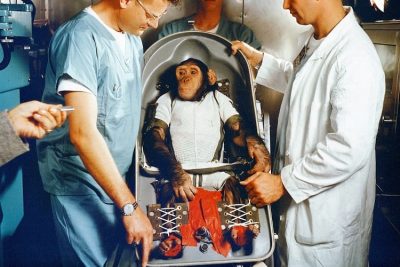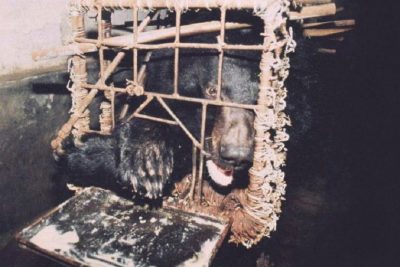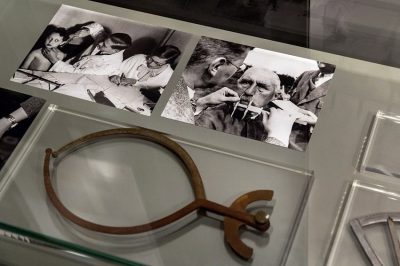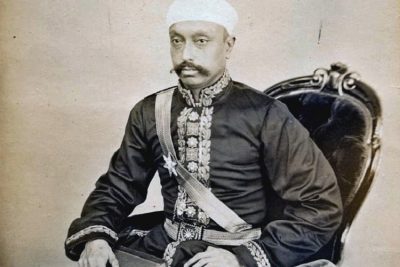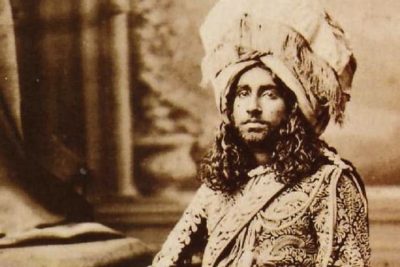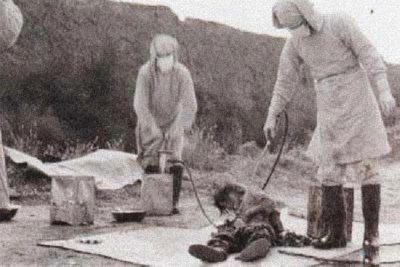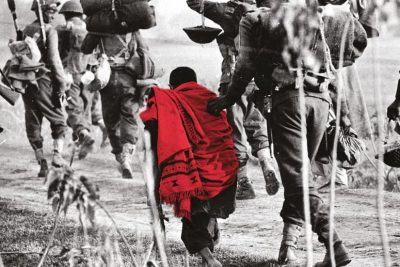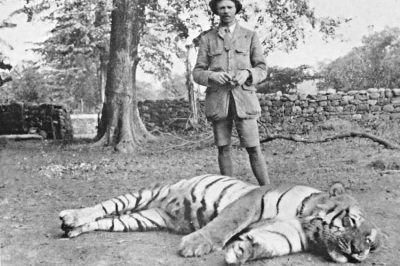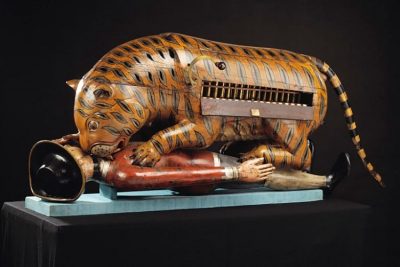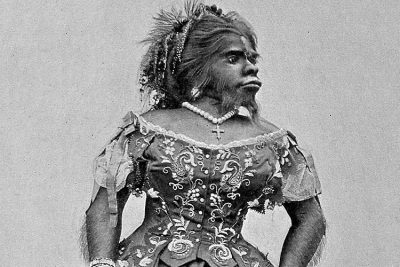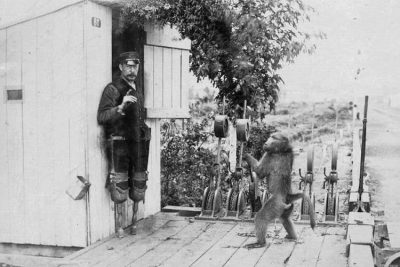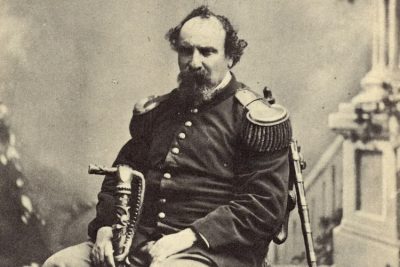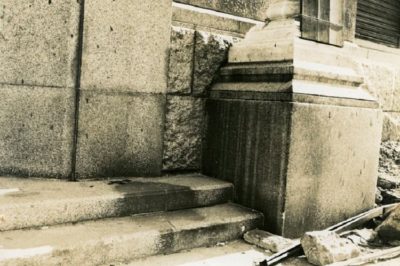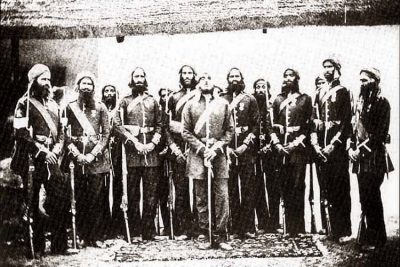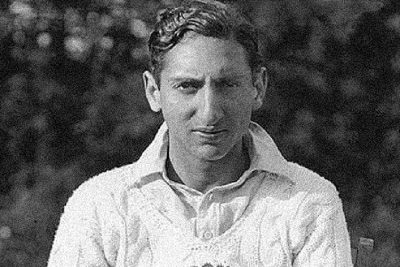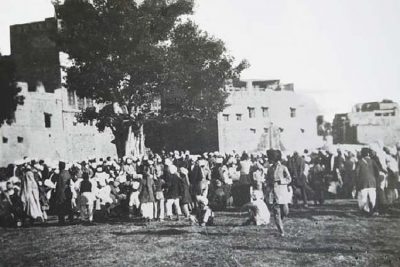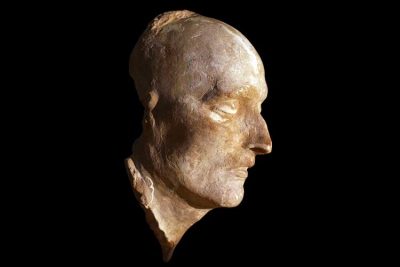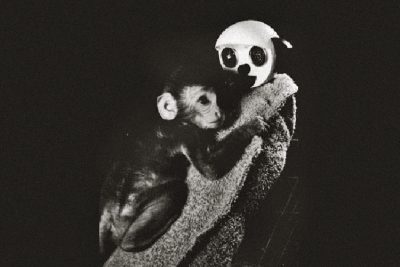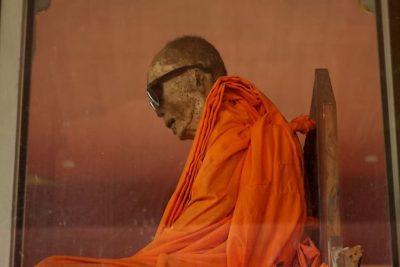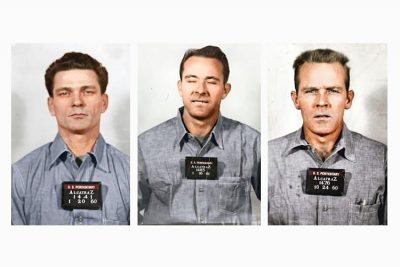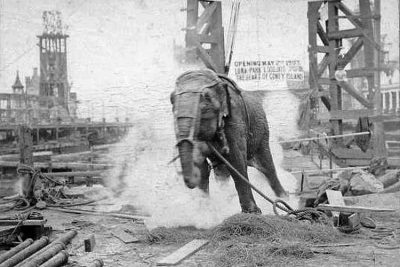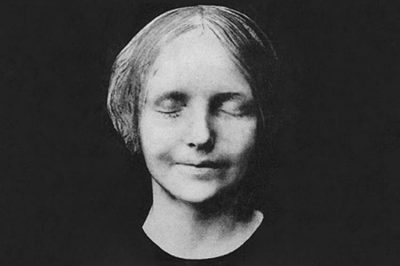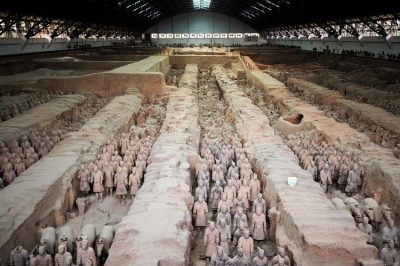The post The Insidious Practice of Bear Bile Farming appeared first on .
]]>
Bear bile farming: A bear named Elizabeth kept in a small cramped cage so that her bile can be extracted. (Photo by the Asian Animal Protection Network in Huizhou Farm, Vietnam)
Chinese medicine practitioners who follow traditional methods use a digestive fluid called bile, secreted from the liver of a bear. The harvest is usually taken from ‘bile bears’, sometimes known as battery bears. A whopping 12,000 bears are subject to bile farming in South Korea, Laos, Myanmar, China and Vietnam.

Asiatic Black Bear. (Guérin Nicolas / Wikimedia Commons)
UDCA or ursodiol, a secondary acid and metabolic by-product of intestinal bacteria are found in bears- mainly Asiatic black bear, Sun Bear and Brown Bear, although other species are also used. The Giant Panda, also of the bear family, is not used for bile farming since it does not produce UDCA.
The Asiatic Black Bear and the Brown Bear have been listed in the “Red List of Threatened Animals” by the International Union of Conservation for Nature, due to the effect of bile farming on their population. Although hunting was prevalent earlier, it has since been cut down. Factory farming has been adopted since hunting was banned in the 1980s.
Oriental medicine and bear bile
Chinese medicine practitioners were the first to use bile as a medicinal product, and its first-ever documented use was in Tang Ban Cao of the Tang dynasty. There are several techniques employed in bile extraction which are all surgical procedures. According to research conducted by Humane Society of United States, the bile produced by a single bear is about 10-20 ml, twice a day.
Bear bile to treat COVID-19
Although WHO has confirmed there’s no cure for COVID-19, the Chinese government has suggested the use of Tan Re Qing injection—on a list published March 4 by China’s National Health Commission, reports National Geographic. Tan Re Qing contains bear bile composed of high levels of ursodiol, that is believed to pacify and alleviate the symptoms of the novel coronavirus disease.
How is bile farming conducted? – methods of extraction
1. Repeated percutaneous biliary drainage
This is a technique that involves locating the gallbladder through ultrasound imagery. After this, the organ is pierced and the bile is taken out.
2. Permanent implantation
Permanent implantation is a technique in which a tube is surgically inserted into the gall bladder via the abdomen. The tube stays there till the time the bear is subjected to bile farming- which may even be for up to 20 years.
3. Catheterization
This process involves the insertion of a steel or perspex catheter into the gall bladder of the bear. The catheter lies under the skin from the abdomen to the hip, and promotes safety for the person who extracts the bile as it is located at a safe distance from the bear’s head.
4. Full-jacket method
The full-jacket method employs the use of a catheter as well. However, in this case, the catheter is permanently inserted into the animal, and the bile is collected in a plastic bag which is in a metal box worn by the bear. This has been considered one of the most inhumane methods by researchers who visited the bear farms.
5. Free drip method
For the free drip method, a hole is surgically made in the bear’s gall bladder, and the product directly drips out from the organ. This is not by any means a safe method for extracting bear bile, as it leaves the wound open for infection putting the animal’s life at risk.
6. Direct extraction by killing
Finally, the now-banned method for bear bile extraction involves the killing of the bear to directly extract the bile from the bear’s gall bladder.
Atrocities committed during bile farming
Bears are subject to bile extraction right from the age of three, and spans for a duration of five to ten years. An average bear provides 2.2kg of bile over 5 years. While in captivity for bile farming, these bears are kept in cages that are often so small in size that they cannot stand up to their full height nor move back and forth. In other cases, they are kept in crush cages with practically no space at the sides, these cages are used to restrain the bear and hold them steady for bile extraction.

Bile bear kept in a cage for bile extraction. (Asian Animal Protection Network)
Apart from these horrific procedures, bears are also subjected to declawing and removal of their hind teeth so that they cannot harm themselves or mutilate their body parts in any way. These precautions help to avoid any reduction in the quality of the bile product obtained from the bears.
By-products from bile farming
Meat, fur, claws and even bear paws, apart from the bear bile, are a part of the huge industry that involves both legal and illegal trade. According to research conducted in 2015, Malaysia had a majority of medicinal products that contained bear bile. In China, only 7600 bears are officially accounted for in the process of bile farming, but according to the amount of produce that is discovered Chinese officials claim that it is equivalent to the product obtained by the slaughter of 10,000 bears.
In the United States, some parks had bear carcasses lying around which indicated poaching. Later it was discovered that the wild bears were being hunted for bile and a smuggling operation was being conducted by a large organization which led to the death of an approximate of 40,000 bears per year. In Virginia, 52 people were held responsible and were taken into custody by officials for the possession of 300 gall bladders. Raw bile, bile pills and powder are among the most popular products that are a part of the bile farming industry. As astounding as it may seem, the products extracted and sold in the market generates a whopping $2 billion in revenue in a year.

Examples of bear bile products seized by the Hong Kong Government. (U.S. Government Accountability Office / Flickr)
Concerns on bile farming and animal protection organizations
Due to the extensive bile farming activities and poaching, among other illegal activities, the number of bears in the world has drastically deteriorated. In 1994, the Chinese government imposed a number of rules to avoid cruelty in bile farming. They issued a proclamation stating that no external object was to be inserted into the body of a bear. Only bears that met certain criteria were to be used. The criteria set was that the bear should be at least 3 years of age and heavier than 100 kg. It was enforced as a “Technical Code for raising Black Bears” with utmost hygiene and care.
In South Korea, bear farming was declared illegal in the year 1992. However, there was no rule on the killing of bears over the age of ten. Even the Vietnamese government declared bile farming illegal in 2005. Despite the enforcement of such a law, the practice is still prevalent and bear farms continued their work illegally. Bear sanctuaries were opened both in Vietnam and China where over 500 bears were rescued by a charitable organization called Animals Asia.
Enjoyed this article? Also, check out “Tiger Farms: Where a Shady ‘Tiger Conservation Business’ Puts the Entire Feline Population at a Greater Risk“.
Fact Analysis:
STSTW Media strives to deliver accurate information through careful research. However, things can go wrong. If you find the above article inaccurate or biased, please let us know at [email protected].
RELATED
The post The Insidious Practice of Bear Bile Farming appeared first on .
]]>The post Humanzee: Was Oliver the Chimp a Missing Link Between Humans and Apes? appeared first on .
]]>
Humanzee: Oliver the chimpanzee. (Wikimedia Commons)
Researchers, over the years, have been on the lookout for the link between humans and apes. When Oliver appeared in the public eye, they publicized him as exactly that—a humanzee—a hybrid between a human and a chimpanzee. Were they correct though, or was it a hoax all along?
Oliver was born in 1957 in the Congo region where he was abducted by animal smugglers. They took him to the United States and, here, in 1970 two trainers, Frank and Janet Berger, took him. They brought him up as a human and he lived with them until he was 16 years old.
Oliver- The Humanzee
The Bergers noticed early on that Oliver differed from the other chimpanzees they had, with whom, incidentally, he didn’t get along well; he showed a distinct preference for human companionship. He had a small head and features that were more human-like than chimpanzee-like. Further, he liked to walk upright on two legs, rather than bent over and using the knuckles of his hands as the other chimpanzees did. The Bergers also found him to be remarkably intelligent and easier to train. He even did chores.

As he became sexually mature, however, his behaviour became problematic. He took a fancy to Janet Berger as a mate and began attempting to mate with her. As he was very strong, the situation could have turned dangerous. The Bergers, therefore, decided that he had to go, and sold him to New York attorney Michael Miller.
Miller hoped to make money by exhibiting Oliver and took him on the road to many places, including Japan. Oliver proved to be a hit there. According to newspaper accounts, over 26 million Japanese came to see him.
In 1977, unable to keep him for various reasons, Michael Miller sold Oliver to a theme park owner named Ralph Hefler. He exhibited Oliver in his theme park, the Enchanted Village, and, after that shut down later that year, he took him to his new venture, the Gentle Jungle. While the location of this new theme park changed a few times, Oliver remained a constant feature in it. After it closed in 1982, Oliver went to Ken Decroo’s Wild Animal Training Center in Riverside, California. He remained here until 1985 until an animal trainer, Bill Rivers bought him.
When Bill Rivers found that Oliver did not get along well with his other chimpanzees, he sold him in 1989. Oliver’s new owner was the Buckshire Corporation in Pennsylvania. It was in the business of leasing out animals to research laboratories for scientific and cosmetic testing.
Fortunately for Oliver, because of his human-like qualities, they spared him the horrors of being used in experiments. Although, when they examined him at the facility, the animal caretakers noticed scars and signs that some of his previous owners may have abused him. Oliver didn’t receive much kindness at the Buckshire Corporation either. The company kept him in a small cage where he could not move about freely. He remained there for nine years, and as a result, developed muscular atrophy. The condition made his limbs tremble when he walked.
Animal activists noticed his pitiful condition, and the animal sanctuary, Primarily Primates, petitioned Sharon Hursh, the president of the Buckshire Corporation, in 1996, to do something about him. Hursh ordered Oliver to be shifted to Buckshire’s retirement colony, where 13 chimpanzees already lived.
As Oliver’s trainers found, his behaviour was like a civilized human. He was not aggressive and was, in fact, enthusiastic about helping with chores. If there was a need to transport hay and straw from stalls, he would be ready to move the heavy load in a wheelbarrow. He acquired human traits of enjoying a cup of coffee and even knew how to mix his own whiskey. He often sipped his drink while watching television.
Last Years of Oliver
In 1998, Oliver moved to the Primarily Primate sanctuary in Bexar County, Texas. He lived here in a spacious, open-air cage.
After the merger of Friends of Animals and Primarily Primate, Oliver continued to live in the facility in the company of a gentle female chimpanzee named Raisin. His years in the research lab had taken their toll, and, half-blind and arthritic as he was now, he was unable to put up with the company of younger, rumbustious chimpanzees. His caretakers allowed him to lead an easy-going existence, with recreational activities such as watermelon smashing parties and painting sessions. They put up photos and news articles online to update his fans about his activities.
On 2 June 2012, when he was 55 years old, the caretakers found Oliver dead beside Raisin. They cremated him and spread his ashes on the sanctuary grounds.
Was Oliver Really a Humanzee?
For most of his life, Oliver was sold to the public as a humanzee, and many people believed it too. The possibility of a human and chimpanzee hybrid didn’t seem too ridiculous to them. As there were examples of other inter-species hybrids, such as a mule (a cross between a donkey and a horse), a liger (a cross between a tiger and a lion), and a zorse (a cross between a zebra and a horse).
Some of Oliver’s exhibitors claimed that he had 47 chromosomes. Chimpanzees have 48 chromosomes, and humans have 46 chromosomes. So, that proved that Oliver was a hybrid.
Towards the end of his life, while he was at the Buckshire Corporation, a geneticist from the University of Chicago tested Oliver’s DNA. And published the findings of this genetic testing in the American Journal of Physical Anthropology and finally put to rest the hybrid rumour. Oliver, it turned out, had 48 chromosomes like any other chimpanzee. Furthermore, his mitochondrial DNA matched that of the chimpanzee subspecies that lived in Central Africa, and his ‘human-like features’ were discovered to be common in those chimpanzees as well.
Although, in the end, Oliver didn’t turn out to be a humanzee, his capacity to think and his human-like actions shed an interesting light on animal behaviour.
Enjoyed this article? Also, check out “Zebroid: Strange Equine Hybrids That Make Their Parentage Shine“.
Fact Analysis:
STSTW Media strives to deliver accurate information through careful research. However, things can go wrong. If you find the above article inaccurate or biased, please let us know at [email protected].
RELATED
The post Humanzee: Was Oliver the Chimp a Missing Link Between Humans and Apes? appeared first on .
]]>The post Horrors of 1971 Bangladesh Genocide Chronicled by Anam Zakaria Through a More Personal Lens appeared first on .
]]> The year 1971 is of great importance not just for Bangladesh and Pakistan, but also for India. It changed the political climate in the subcontinent for years to come. We have enough political accounts that serve the state narrative of the three nations involved, but very few to document the horrors experienced by civilians. In her book, 1971: A People’s History from Bangladesh, Pakistan and India, Anam Zakaria, oral historian and author explores what it means to belong, drawing on harrowing accounts of lives tangled in the struggle for freedom.
The year 1971 is of great importance not just for Bangladesh and Pakistan, but also for India. It changed the political climate in the subcontinent for years to come. We have enough political accounts that serve the state narrative of the three nations involved, but very few to document the horrors experienced by civilians. In her book, 1971: A People’s History from Bangladesh, Pakistan and India, Anam Zakaria, oral historian and author explores what it means to belong, drawing on harrowing accounts of lives tangled in the struggle for freedom.
By examining the social narrative, Zakaria creates a kaleidoscopic collage of memories that are haunting, personal and sincere.
Bangladesh didn’t gain Independence at the stroke of midnight like its neighbours; India and Pakistan under the Indian Independence Act of 1947. Partition didn’t give birth to Bangladesh rather it was the war of 1971. The Liberation War as known in Bangladesh, between the two wings of Pakistan; East Pakistan and West Pakistan culminated into dismemberment of the former wing into a new state- Bangladesh; The Country of Bengal.
The fight for liberation officially began in March 1971 as a response to the Operation Searchlight carried out by the military regime of West Pakistan to curb the voices of nationalist Bengali intelligentsia. But the seeds for the movement were sown soon after Partition as the Language Movement. This movement was headed by the intellectuals of the erstwhile East Pakistan rallying against the repression of the cultural and social identity by an authoritarian government.
“The language issue was a catalyst indeed and, in hindsight, is popularly understood to be a major source of rupture.”
In Chapter 5 of the book, Zakaria interviews Bangladeshi academics and historians who lived through the massacre.
“Through the following interviews, this chapter seeks to explore the more personal impact these events had on the lives of East Pakistanis, and the nuanced ways in which they transformed from Pakistanis to Bangladeshis before the latter even took birth.”
One of the interviewees is a historian and writer, Professor Muntassir Mamoon of Dhaka University. Mamoon as a young man in the 1960s closely observed the political shift of powers in the years leading to the war. He talks about incidents that yielded his transformation from a patriotic Pakistani to a supporter and member of the Bangladesh movement. Along with the other writers, Mamoon helped foreign journalists document the carnage as it took place.
“Mamoon had dedicated his life to archiving, writing and teaching about 1971, while also advocating for war crimes trials in Bangladesh. He was committed to ensuring that the memory of 1971 was not forgotten.”
In his efforts to not let the memories of the genocide be erased from the public mind, he founded the genocide and torture archive and museum in Khulna district of Bangladesh. In Mamoon’s museum, one of its kinds in South Asia, are rare collections of photographs, paintings and relics showcasing the horrific realities of the ninth month-long butchery.
“Before we left, Mamoon gave us a tour of the museum, showing us photographs of vultures picking on the bodies of Bengali men and women, images of dead children, their eyes popping out, their legs bitten off by animals.“
Of her tour around the museum, Zakaria comments on drawings by young school students depicting their understanding of the war and the Bengal armed resistance. These drawings evoke strong feelings of loss, pride and victory. Observing this she says Mamoon’s mission to keep the flame of memories burning has been accomplished.
“These were the vivid memories, the photographs, the clothes, the rooms and the spaces, which kept 1971 alive. These were the expressions of the war, the living memory of 1971. There would be no letting go.”
Anam Zakaria as an oral historian undertook great efforts to understand and document the personal narratives and sentiments of the subjects of the 1971 movement. All her efforts helped her deliver a perspective in 1971: A People’s History from Bangladesh, Pakistan and India that is often overshadowed by the state interests.
 1971- A People’s History from Bangladesh, Pakistan and India | By Anam Zakaria
1971- A People’s History from Bangladesh, Pakistan and India | By Anam Zakaria
“Through a personal journey, she juxtaposes state narratives with people’s history on the ground, bringing forth the nuanced experiences of those who lived through the war. Using intergenerational interviews, textbook analyses, visits to schools and travels to museums and sites commemorating 1971, Zakaria explores the ways in which 1971 is remembered and forgotten across countries, generations and communities.”
RELATED
The post Horrors of 1971 Bangladesh Genocide Chronicled by Anam Zakaria Through a More Personal Lens appeared first on .
]]>The post Bhopal Gas Tragedy: India’s Very Own Chernobyl That Affected Over Half a Million People appeared first on .
]]>
Survivors of Bhopal gas tragedy at Chingari Rehabilitation Centre. (Bhopal Medical Appeal / Flickr)
Why should modern technology go hand in hand with orthodoxy? Because we are too poor to afford a whole lot of automated systems. We have a huge number of unemployed people waiting to be given jobs. But, we must industrialize to become a ‘developed nation’. So we invite a multinational for a project. Pamper it in cocktail circuits. And when it gets going, we put a speed breaker. The multinational is forced to cut cost and go slow. The nose and the eyes of the labour, it is presumed, are enough to detect anything out-of-order. The whole system is forced into lethargy, and the way is crafted for the world’s biggest industrial disaster. That’s the story of the Bhopal gas tragedy that killed 3,500 people within days, but as many as 25,000 people have died from related illnesses and affected more than 500,000 people.
It began with inviting foreign direct investment
The intervening night of 2nd and 3rd December 1984 couldn’t have been more catastrophic. Union Carbide India Limited (UCIL) Bhopal, a subsidiary of Union Carbide Corporation (UCC) of America, released a huge amount of a toxic chemical in the air, accidentally. The chemical, methyl isocyanate (MIC), was stored in a tank in amounts exceeding the regulatory mandate. In the normal course, it would be used in the making of the product, an insecticide, called ‘Sevin’. Sevin was imported to India till the Indian government decided that it must be manufactured within the country. So, UCC was invited to establish a manufacturing unit for the Insecticide at Bhopal.
A sudden policy change was enforced
Accordingly, UCIL, the subsidiary of UCC in India since 1934, acquired land in Bhopal in 1969 for the manufacturing unit of ‘Sevin’. The American Company was directed to raise that at least one-fourth of the venture capital from local shareholders. The government itself had a 22% stake in the company’s subsidiary, Union Carbide India Limited (UCIL).
All was a honeymoon and hunky-dory between UCC and the Government of India till 1973, when a new act FERA [Foreign Exchange Regulation Act] was introduced, which required the dilution of foreign equity from 60 per cent to 40 per cent.
The UCC, which owned a 60 per cent stake in Union Carbide India decided that the company should reduce its investment to the Bhopal plant from $28 million to $20.6 million in order to retain control of its Indian subsidiary, and this meant poor safety standards. They also sought exemption from FERA by proposing to manufacture methyl-isocyanate (MIC) in Bhopal, which was later granted under “strict guidelines” in 1975.

The exterior of Union Carbide pesticide factory. (Bhopal Medical Appeal / Flickr)

Inside the Union Carbide pesticide factory. (Bhopal Medical Appeal / Flickr)
The decade of 1980 was tumultuous for India
The first half of the 1980s was a politically volatile phase for India. The state of Punjab saw terrorism in the name of a separate homeland for Sikhs. Reign of Terror was part of Pakistan’s plan to cut off Punjab from India in the form of a new nation, Khalistan. The Indian government was forced to conduct Operation Blue Star to flush out terrorists from the golden temple in Amritsar. The hurt Sikh sought revenge by assassinating Mrs Indira Gandhi, the then Prime Minister of India, on the morning of 31st October 1984. This was followed by large scale pogrom that selectively killed Sikhs living in Delhi and other Indian cities. And that same year, on the intervening night of 2nd and 3rd December, the toxic gas MIC, leaked from the Bhopal plant, leaving a trail of death, and endless debate on ‘who was responsible’. Given the kind of political scenario prevailing at that point in time, sabotage wasn’t ruled out.
Count down began with indiscriminate cost-cutting
No doubt, someone in the Bhopal factory trespassed on duty. Someone was negligent. Otherwise, the lethal gas wouldn’t have leaked in such amounts as triggered death and incapacitation on a massive scale. But, first thing first. What really set the ball rolling? Doubtless, the cost-cutting exercise. There is a saying that you never know what enough is unless you have had more-than-enough. So, the innocuous and innocent-sounding cut-cost was the first step. It created a system which, over a period of time, became a harbinger of a lackadaisical production house.
Professionalism in the plant was reduced to a charade
As mentioned by The New York Times,
“The seeds of the accident were planted in 1972 when, under Government pressure to reduce imports and loss of foreign exchange, the company proposed to manufacture and store MIC at the plant”
Cost-cutting measures initiated in 1972 implied that technical staff, computers, and modern equipment must be reduced to a minimum. The lowering of standards led to increased employee turnover, and the number of rookie employees sitting on controls.
The workforce at the Bhopal plant had no expertise in sensing danger and tackling it timely. All they tried to do was to work in piecemeal and adhere to rule book as best as they could. In the process, they developed short cuts and go about their job mechanically, without foresight. What happened on 2nd December 1984 was a reflection of this attitude. Stored quantity of methyl isocyanate (MIC), a constituent of the finished product ‘Sevin’, rose to 63 tons. Of this lot, 42 tons were stored in tank number 601. That was full capacity fill even as the rule book said that the tank should never be filled more than half of its total capacity. The excess of MIC, as per the rule, should have been moved to a spare-tank. But, the spare-tank was full too. Workers had inadvertently got used to keeping even the spare tank full. That was a mistake. And there were many more mistakes. Like, all MIC was required to be cooled to a lower temperature. But the refrigerating unit was disbanded as part of the cost-cutting exercise. A scrubber cylinder meant for neutralizing toxic leaks, and a burner for the same purpose were dismantled for servicing.
High employee turnover affected the work culture
Workers on duty had reported leak at 11.30 PM on 2nd December. It was the toxic gas, MIC, starting to leak. In an hour’s time, the leakage became uncontrollable and people living in the vicinity began waking up due to lung distress, burning eyes and vomiting.

Control room safety board inside the abandoned Union Carbide factory. (Bhopal Medical Appeal / Flickr)
Investigations revealed that the Bhopal plant wasn’t able to sell all the Sevin it produced. It was sales deficit since 1982. Ensuing losses forced many highly trained professionals to quit the job and move to more prospective work areas. As plant lost money, management focussed on the economy to the serious detriment to safety norms. The leak, which was misconstrued as water-leak, was the doing of an untrained worker (less paid and hence fitting into cost-cutting exercise). The worker was directed by a trainee supervisor to wash an improperly sealed pipe, an act prohibited by the rule book. Through the defective seal, water seeped into the already overfull tank number 601. The stored MIC reacted with water raising internal pressure to a level where MIC broke through the tank cover. Of the three safety systems installed in the manufacturing unit, one had been taken off for servicing. The remaining two were unable to control the overwhelming leak.

Safety sign inside the now-abandoned factory. (Bhopal Medical Appeal / Flickr)
Even alarm systems were not distinctive
Shakil Qureshi, a MIC supervisor, revealed that the staff was used to defective and unreliable gadgets in the factory. Hence a gadget that worked well, got ignored too. He himself had noticed that pressure in one MIC tank shot up five times in an hour’s time. But didn’t realize it indicated danger. Tragically, the alarm that rang to alert for MIC leak went unnoticed. Reason being the sound of the alarm was no different from other alarms including one used for calling practice drill.
Prudence being the watchword in Bhopal plant, computer systems which could monitor operations, and sound timely warning to attending staff were not installed. Workers can sense irritating leaks using their sense of sight and smell, thought the Indian management. But the UCC manual clearly said, ‘Although the tear gas effect of the vapour is extremely unpleasant, this property cannot be used as a means to alert personnel.’ Budget restrictions reflected on the training of the manpower too. Employees knew they worked in an unsafe environment. In 1983, the number of operators in a shift was reduced from 12 to 6. Kamal K. Pareek, a chemical engineer had remarked in 1971: “(the plant) cannot be run safely with 6 people”. No public relations exercise was ever done to familiarize the city of Bhopal with what the factory was doing. And what possible dangers it posed to life and the environment around it.
Gas-leak created all-around panic
The circumstances were favourable for a tragedy of epic proportions. Panic was naturally the first reaction of workers in attendance at the pesticide factory. There were buses in plant premises which could have ferried them quick and far. But fear was so overwhelming that the vehicles were ignored. Poignantly though, as it emerged later, even running helter-skelter didn’t help. People who stayed put in their home, willingly or helplessly, survived. And those who ran out met toxic clouds on way and died a painful death.
Approximately 40 tonnes of methyl isocyanate, along with other toxic chemicals, got released from the Bhopal factory. The toxic MIC floated at random, killing people in running trains, on roads and wheresoever it could dip or rise with the free-flowing air. Slums and villages near the factory were worst hit. Half of the 8.5 lakh population of Bhopal city coughed, suffered difficult breathing, and itch in eyes and skin. Internal haemorrhages, pneumonia and respiratory failure caused deaths on a large scale.
Doctors panicked
No public alarm was raised by the UCIL. The fatal hit of floating MIC clouds caused mayhem, and people rushed to hospitals in large numbers. Government hospitals, only 2 in number then, neither had the capacity nor the expertise to treat such large number of toxic gas patients. Confusion in the medical circle was so paramount that even routine drug, sodium thiosulphate, wasn’t used in the period it was critically required. Instead, doors of UCC were beaten for medical guidance. A formal guidance was provided, but that was inadequate. The government claimed that the leakage of MIC was stopped in 8 hours. But the effect and after-effects of gas leak remain even to this day, i.e. 35 years after the incident happened. The overall tally of the dead is over 25,000 people. Thousands got deformed as the toxic effect was genetically transmitted to the next generation. Even now, the newborn show tell-tale symptoms of physical and mental deformity.

Birth defects are still reported children in the region. (Bhopal Medical Appeal / Flickr)
Let us look hard on our own selves
Now, let’s separate the grain from the chaff. UCC America and the state of India were pitted against each other in a legal battle. Naturally, both accused each other for the Bhopal tragedy. Warren Anderson voiced sabotage theory which was rebutted by the Indian side. A detailed investigation led to the conviction of some employees in the chain of command and they were punished as per the Indian laws. Compensation, as decided between American and Indian courts, was doled out to victims. Many NGOs worked, and are still working for the rights of the gas affected. And there is a feeling in the Indian camp that justice was delayed, and dispensed in favour of America. But, let us rewind and begin from the very start. UCC was given business opportunity in Bhopal purely on merit as it was already operating in India as Union Carbide India Limited since 1934. The product it was called upon to make-in-India, Sevin, already had a market. Those were the days when the green revolution was at peak and pesticide were deemed indispensable for agricultural crops. And, just when UCC was all geared up to deliver a classy industrial unit, the Indian side said: gear down. We don’t want machines that would make human labour redundant. We have an acute shortage of jobs. We want the Bhopal factory to be a job provider for the local population. And UCC was forced to step back and cut costs ear-marked for computer technology which alone could have ensured safety to the Bhopal plant. Political compulsions of the day came in way of the state of art industrial technology. And, the Bhopal plant became a cross between technique and tradition.

Union Carbide pesticide plant today in Bhopal, India. (Julian Nyča / Wikimedia Commons)
India’s disaster management record is poor
If past is any guide, disaster management or crisis management in India leaves much to be desired. Rhetoric overtakes logical investigation. Political posturing comes into the forefront. If the diagnosis and treatment of the patients remained in suspense for long, we can’t blame America for it. It was natural for India to bay for Anderson’s blood. But let’s not forget, he wasn’t responsible for the cost-cutting drive, nor for the loss of market for Sevin. And let’s not forget that the only consistent finding, the only undisputed finding, in the entire trail of investigation is mismanagement. The emotional quotient of the tragedy shouldn’t blind us to the fact that it was our own policy-making which paved way for a tragedy of this magnitude. Chaos and mayhem that followed the gas leak, didn’t permit a fair and time-bound investigation. In fact, sabotage under those conditions could have very well happened, without leaving any trace for the investigation agencies.

Bhopal gas tragedy memorial statue. (Bhopal Medical Appeal / Flickr)
The Indian and the American judiciary worked in top gear
Judiciary in India, as well as America, have done their part on the issue. UCC paid a compensation of $470 million for the victims in 1989. Politicking on the issue made waves even in 2019 general elections. In the 35 years past this tragedy, political parties have blamed one another for the disaster and siding with the American company. The CEO of Union Carbide and the chairman of UCC, Warren Anderson, was seen as the main villain behind the gas disaster. He died on Sept 29th 2014, without being deported to India to face trial. Many believe he escaped punishment for two reasons. One, protection by the US government. Two, negligence of the Indian government.
Author’s Opinion
So the takeaway from Bhopal disaster is that let’s clean our own house first. Let’s not compromise with professional expertise. Giving jobs to untrained and unqualified people is no way to remove unemployment, or save a business from loss. Politicians shouldn’t play to the gallery in matters of hardcore business. This is the only way out to prevent tragedies, like the Bhopal gas-leak, in future.
You can make a donation to the Bhopal Medical Appeal and help fund the important work taking place at Chingari: bhopal.org/donate/
Also, check out “The Bengal Famine of 1943: The Man-Made Famine That Killed Around 3 Million Indians“.
Fact Analysis:
STSTW Media strives to deliver accurate information through careful research. However, things can go wrong. If you find the above article inaccurate or biased, please let us know at [email protected].
RELATED
The post Bhopal Gas Tragedy: India’s Very Own Chernobyl That Affected Over Half a Million People appeared first on .
]]>The post Champawat Tiger: The Killer of 436 Humans is a Case of Animal-Need Pitted against Human-Greed appeared first on .
]]>
The head of Champawat Tiger. (Nihal Neerrad S / Wikimedia Commons)
Today, the Asian Tigers are a threatened species with just about 3200 thriving units. The number was a lakh (hundred thousand) a century back. The most numerous subspecies, Bengal Tigers, is reduced to 2500 and is also endangered according to IUCN. Man’s itch for infrastructure development and professional hunting has led to this drastic depletion. Tigers are not the natural enemies of man, but may turn on him following injury, and the exigencies of living space. The story of the Champawat tiger, a Bengal tigress that killed 436 humans, is a classical example.
The killing started in Nepal and extended to Kumaon
In the 19th century British ruled India, a Bengal tigress in the Himalayan range of Western Nepal turned into a man-eater. A man of Tharu tribe from Rupal village was her first victim. Professional hunters were called and put on the mission to kill the tigress. But the tigress was too swift and cunning to be caught. Next, in an upscale measure, the army was put on job. Army gheraoed the tigress (who, post her death much later, would be named as Champawat Tiger), but she escaped by crossing over to an adjoining habitat.
Kumaon district, across river Sarda, became her new home, and a terror zone for the natives living there. For seven years, the tigress struck men women and children with brazen audacity, even during the day time, if the opportunity presented itself. An estimated 436 humans fell prey to the deviant wild cat.
Only hassled and handicapped tigers attack men
Tigers normally don’t attack humans for food. They do so only in some exceptional circumstances. In the case of Champawat tiger, it was a hunter’s bullet that failed to kill her but smashed her upper and lower right canines. This injury constrained her from catching its natural prey. And the pangs of hunger forced the tigress to an easier catch, the humans. Another contributing factor was the rampant deforestation done by the British government. The exercise done in the name of infrastructure development was a direct infringement on the living space of the wildlife.
Verily, a fight between man and nature
As man was busy asserting his power on nature, the Bengal tigress was out asserting her power on mankind. Best time for the kill was the day time, when men moved out for work. So, most of her attacks occurred during the day. Even those who rested in the 4 walls of their homes, weren’t spared. Human habitation became her food-spread which she walked into whenever hungry.
Surreptitious killings created mayhem
Ferocious canine teeth, brute power and the quick reflexes of a tiger can freeze any human with fear. The ears of a tiger can hear a wide range of frequencies from 0.2 kHz to 100 kHz, they also have a strong sense of smell. Ears can also rotate on base to catch sound from a particular direction. These endowments make the big cat a stealth killer. Time and again skilled hunters, police and military were engaged to kill the tigress, but to no avail. Orthodox and the God-fearing natives even started believing that it was some kind of a curse from the nether world. Gripped with fear, people stopped moving out of homes. Ironically, even homes weren’t safe. The tigress attacked people sleeping in huts, travelling on boats and even those who perched on trees.
Finally, the British administration couldn’t take it any longer. In the year 1907, the deputy commissioner of Nainital, Charles Henry Berthoud, was determined to do ‘something’. He went out to meet his friend, Jim Corbett.
Jim Corbett was tasked to kill the man-eater
Jim Corbett was a renowned hunter and a railroad worker of Irish lineage. Born and brought up in Kumaon hills, he had spent quality time with native hunters of Kaladhungi forests. Killing of a leopard at the age of 10 was his first landmark, and many more would follow. Berthoud wanted Jim to go after the Bengal tigress. Even though Jim had no hands-on experience of dealing with a man-eater, he agreed to give it a try. He didn’t have to wait for long to go ahead on the task. A fresh killing was reported just 5 days later. A woman astride a tree, plucking leaves for fodder, was pounced upon and killed. This happened in a town 60 miles away. Jim packed up, took six natives as helpers, and headed towards the town.
Village Champawat became the name and the nemesis
On reaching the destination, he saw villagers in a state of shock. As for the tigress, there were no signs of her. So, he decided to wait and watch. A nearby village, Champawat, was frequented by the tigress in the past. The village would go on to become the nemesis, as well as the enduring identity of the tigress as ‘Champawat tiger’. On the advice of the villagers, Jim moved towards this village and got the ultimate lead, a yet another kill. A 16-year-old girl was mauled by the tigress and dragged deep into the woods. The trail was marked by fresh blood. Jim followed the trail and found the victim’s skirt in a distant valley. In the near vicinity were seen scattered pieces of bones, and a severed human leg. Warm blood was still oozing from the leg. Obviously, the man-eater was somewhere near. The thought gave him a mix of hope and fear, and an alert Jim spent hours sitting in a hideout, his finger pressed to trigger. But the big cat eluded him, and he was forced to return.
Massive manpower was used in the final assault
On the day next, Jim reached the valley with a team of 300 villagers. The team spread out into a wall that forced Champawat tiger in a direction where Jim lay in wait. The human wall screamed, beat drums and used firearms to intimidate the animal. With a pounding heartbeat and loaded gun, Jim was now ready for a tryst with destiny. A tiger leaping with lightning speed would give him only a couple of seconds to take aim and shoot. Missing the aim would cost him life. So, for him, it was a matter of do-or-die.
The beast fell to the second round of firing
The moment of reckoning finally arrived. Jim saw some stripes emerge out of shadows. It was the tigress. Corbett fired a shot, which missed the mark. He fired again, this time it hit the animal. Third shot too was on target. But high on adrenaline, the big cat still surged for an attack. Out of ammunition, Jim ran for his life. Sprinting across the valley as fast as he could, he took a shotgun from a colleague, ran back to the hit-but-alive tiger, and fired a volley of bullets from 20 feet distance. With that, he called it a day.
Champawat Tiger made a world record
Death of the Bengal tigress was widely celebrated. But, for Jim Corbett, it was a solemn occasion. Death of the tiger weighed heavy on his mind even as there was relief and satisfaction of a job done. Post mortem findings revealed her broken canines, the prime reason for her turning into a man-eater. The tigress entered in Guinness Book of world records for killing the highest number of humans, i.e. 436. It is believed she may have killed more, as many cases may have gone unreported.
Many more man-eaters were put to death
Post the killing of the Champawat tiger, Jim Corbett was engaged in the extermination of other man-eating tigers too. The last man-eater he killed was in the year 1938, at 63 years of age. A celebrity, and bestselling author of 6 books, he was an animal lover and a committed conservationist at heart. The declining number of tiger population perturbed him even during his lifetime. So much so, he devoted the last 2 decades of his life for the protection of tiger species. Corbett national park at Nainital, Uttarakhand, committed to protecting the endangered Bengal tiger, is a fitting tribute to this outstanding naturalist, hunter, and lover of the wildlife.
Jim Corbett rooted for the conservation of wildlife
Tigers are “a large-hearted gentleman with boundless courage”, opined Jim. They turn man-eaters when wounded, and in some exceptional circumstances, he added. From the man-eating tigers in the past, to the threatened-with-extinction tigers at present, the time has come a full circle. The need of the hour is to conserve tigers at all cost. Otherwise, as Jim Corbett rightly said: if the tiger goes extinct, India will be poorer.
Enjoyed this article? Also, check out “Jim Corbett: A White Hunter Who Became Saviour of Tigers“.
Fact Analysis:
STSTW Media strives to deliver accurate information through careful research. However, things can go wrong. If you find the above article inaccurate or biased, please let us know at [email protected].
RELATED
The post Champawat Tiger: The Killer of 436 Humans is a Case of Animal-Need Pitted against Human-Greed appeared first on .
]]>The post Sarah Baartman: Tragic Life and Times of the Enslaved African Woman, Exploited for Her Large Buttocks appeared first on .
]]>
Artwork of Sarah Baartman being used as an exhibit. (A Paris chez Martinet)
It is humiliating to be gawked at. But, it is even more humiliating and infuriating if you are touched, groped, exploited, subjugated, violated, penetrated and destructed under inhumane conditions. That’s exactly what happened to Sarah Baartman some 200 years ago.
Sarah Baartman was born as Sawtche or Ssehura or Saartjie, meaning the diminutive form, in 1789. Being just 4ft 7in tall, she belonged to the Khoikhoi nomadic tribe that lived in the eastern part of the Cape Colony of today’s South Africa.
Sarah’s mother belonged to South Africa’s oldest tribe
The life of Sarah was full of hardships. Her mother died when she was just two-years-old. Her father, who was a cattle driver, died when she was a teenager. Sarah’s mother belonged to the oldest tribe in Southern Africa, Khoi tribe.
Women of that tribe had a lighter skin tone and well-developed hips. In Sarah’s mother’s tribe, developed hips was a sign of beauty at that time.
Khoikhoi tribeswoman had large buttocks
Sarah’s hardships multiplied after she worked as a domestic help in Cape Town in the house of a Dutch Doctor named William Dunlop. Dr Dunlop purchased her from her previous employer, an Afrikaans farmer.
Being a Khoikhoi tribeswoman, by this time Sarah developed large buttocks, which in medical terms is known as steatopygia. It is a state in which a woman or sometimes a man accumulates substantial levels of tissue on the buttocks and thighs.
Such a buildup of fat also extends to the outside and front of the thighs. Thus, producing a curvaceous figure in the tribe’s women. The genetic characteristic of steatopygia can also be found in women of sub-Saharan African origin, pygmies of central Africa and the Onge tribe of the Andaman Islands.
Sarah’s physical condition fascinated Europeans
Sadly, this physical condition made her a cause of fascination to the white European colonizers of the early 19th century. They, thus, made their biggest mistake by racially categorising Sarah or Saartjie Baartman as a sub-human and physically exploiting her.
Doctor Dunlop, who at that time was working for the Royal Navy, used Sarah as his slave and sexual servant in Cape Town for some time. Later in 1810, he and his partner a mixed-race entrepreneur named Hendrik Cesars took her to London. There they changed her name to Sarah or Saartjie.
Dunlop and Cesars organized freak shows
Once in London, Dr Dunlop and Cesars convinced Sarah that she could become rich if she exposed her body. Innocently, she accepted the proposal without hesitation. Then for the next few years, Dunlop and Cesars organized freak shows across England and made her expose across cities in the kingdom as well as the Netherlands.
She was treated like an animal. She walked, stood, sat or danced obediently. The white people saw her with stupefaction, astonishment, disgust and amusement. Both men and women touched her.
Sarah was the testimony of the black race’s inferiority
Meanwhile, scientists and doctors started throwing up all types of theories in explaining Sarah’s anatomy. For them, Sarah was the testimony of Black race’s inferiority and she was a victim of some kind of sickness. Also, as Sarah’s sexual organs were abnormal, the scientists said, she was suffering from macronymphy.
A young Jamaican activist against racism and slavery, Robert Wedderburn, formed a support group for Sarah. He also initiated legal pressures on the British government to put a stop to such freak exhibitions.
In 1814, Cesars took Sarah to Paris
To avoid such pressures, in 1814, Cesars took Sarah to Paris. There she was exposed at various venues including a circus. They called her the Hottentot Venus or Black Venus, which means a Khoikhoi person. Slowly and surely Sarah was forced into prostitution during private gatherings. In such gatherings, she was considered as a true sex object.
Sometime around this period, zoologist and surgeon Georges Cuvier used Sarah as the subject of studies. Georges Cuvier was also the surgeon of Napoleon Bonaparte. The zoology professor was also the administrator of the National Museum of Natural History of France.
Georges Cuvier said Sarah was the missing link between man and animal
According to Georges Cuvier, Sarah was most likely the missing link between man and the animal. Georges Cuvier is believed to have asked permission to formally study the Bushman woman with better precision.
After completing his research, the professor compared the face of Sarah with that of an orangutan and then said her buttocks appeared like female mandrills.
Sarah Baartman’s death
Unfortunately, on 29 December 1815, Sarah Baartman died in Paris at the age of 26. She died poor and of shame and disease. At the time of her death, she had pneumonia and/or syphilis, and also she suffered due to alcoholism. Soon after her death, the professor dissected her body. Before doing so, he made a plaster cast of Sarah’s body.
He then displayed her remains in Paris. In 1817, the professor presented his research work at the Academy of Medicine. According to his study, the black African people were condemned to perpetually inferior.
Until 1975, the genitals, brain, skeleton and a plaster cast of her body were exposed to the general public in Paris. After becoming the president of South Africa in 1994, Nelson Mandela requested the French government to return Sarah’s remains.
The fate of Sarah Baartman’s remains
Sadly, the French government initially declined. Later in March 2002, they accepted the request. On August 9, 2002, Sarah Baartman ’s remains were buried in the area of her birthplace in Eastern Cape about 192 years after she had left her nation.

Sarah Baartman’s burial site. (Leo za1 / Wikimedia Commons)
Over several years many books have been published about Sarah’s treatment and cultural significance. Sarah’s life and times were covered in the 2010 film ‘Black Venus’ and also in the 1998 documentary ‘The Life and Times of Sara Baartman’.
There happen to be many more details about Sarah’s life that continue to be unknown and unconfirmed. People today cannot undo the damage inflicted on Sarah. The least we can do is summon enough courage to speak the naked truth that might comfort her soul. One must remember that she was perhaps the first recorded Black female to be a victim of trafficking.
Enjoyed this article? Also, check out “‘Ape Woman’ Julia Pastrana: The Sad and Short Life of the Ugliest Woman in the World”.
Fact Analysis:
STSTW Media strives to deliver accurate information through careful research. However, things can go wrong. If you find the above article inaccurate or biased, please let us know at [email protected].
RELATED
The post Sarah Baartman: Tragic Life and Times of the Enslaved African Woman, Exploited for Her Large Buttocks appeared first on .
]]>The post Development of the Eugenics Movement in the United States appeared first on .
]]>
A tool to measure the skull. (Ilya Varlamov / Wikimedia Commons)
Eugenics is about preserving and improving the genetic stock of dominant groups of human beings. It has played a significant role in the history of the United States, causing people to be ill-treated, ostracized, sterilized, and even put to death. The set of beliefs that gave rise to eugenics are still prevalent, although they are now known by other names to give them a more socially acceptable and politically correct veneer.
The origin of eugenics
The idea of eugenics came to the USA from the UK and Europe.

Portrait of Sir Francis Galton. (National Portrait Gallery)
In the 19th century, Charles Darwin’s theory of evolution caused a huge stir around the world. Influenced by this theory, the geneticist Sir Francis Galton—who was Darwin’s cousin—began to consider the Darwinian concept of ‘survival of the fittest’ in the context of human beings. He studied the British upper classes and surmised that they retained their high social positions due to their superior genetic makeup.
It was proof that if mentally and physically superior human beings intermarried with other mentally and physically superior human beings, their progeny would be at an advantage. And, in the long term, it would lead to a race of superior human beings and, thus, fuel the evolution of the human race.
The proponents of such selective breeding had the Anglo-Saxon, Nordic, and Germanic people as their ideal of genetically superior humans. According to them, only such people had the right to breed and multiply and inherit the Earth.
Eugenics movement in the United States
The US American eugenics movement developed from Sir Francis Galton’s notions of biological determination, and it received wide support from the US government, the US corporations, the US academics, and the US public.

A health certificate issued by Kansas state board of health, certifying that the family has passed the fitter families examination and is entitled to be classified in A grade. December 18, 1920. (Chronicling America: Historic American Newspapers. Lib. of Congress)
The Carnegie Institution, the Rockefeller Foundation, the Harriman railroad fortune, and other well-known corporate foundations were at the forefront of supporting the eugenics movement. They funded research and organizations concerned with eugenics.
The immigration restriction league
The Immigration Restriction League was established in 1884 with the aim of barring inferior races from immigrating to the United States and threatening the superior Anglo-Saxon stock. They wanted to establish a literacy test to determine the intelligence levels of potential immigrants, but US Presidents vetoed such literacy immigration bills in 1898, 1913, and 1915. In 1917, however, the US Congress overruled President Wilson’s veto on the bill.
Eugenics associations

A poster advocating Eugenics. (Wikimedia Commons)
The American Breeder’s Association was established under the direction of the biologist Charles B. Davenport in 1906. Their mission stated that they intended to investigate human heredity traits and stress on promoting superior blood and informing the public about the social menace of inferior blood. The inventor Alexander Graham Bell, Stanford president David Starr Jordan, and the botanist Luther Burbank were some of the notable members of the American Breeder’s Association. The Association paired up with the Immigration Restriction League and established a Committee on Eugenics in 1909.
The same year, with funds provided by J. H. Kellogg, the eugenicists established the Race Betterment Foundation in Battle Creek in Michigan in 1906. Five years later, in 1911, Charles B. Davenport and the American Breeder’s Association established the Eugenics Record Office in Cold Spring Harbour with funds provided by the Harriman railroad fortune and the Carnegie Institution. Along with Davenport, leading US Americans like the psychologist Henry H. Goddard, the conservationist Madison Grant, and the sociologist Harry H. Laughlin were involved with the project.
The Eugenics Record Office set about collecting and recording the family pedigree information of US American citizens. They analyzed the data and drew the conclusion that people from socially and economically backward classes produced unfit specimens. To resolve the social problem of these unfit individuals, the leading intellectuals lobbied to the government for various solutions such as restricting immigration, deporting the unfit, sterilizing the unfit, segregating the unfit, and even exterminating the unfit.
The eugenicists thought such drastic methods were perfectly justifiable for the greater good.
Marriage and sterilization laws
In 1896, Connecticut enacted marriage laws that prohibited epileptics, imbeciles, and feeble-minded people from getting married. The following year, in 1897, Michigan attempted to pass a bill proposing compulsory sterilization for the unfit. However, most of the Michigan legislators refused to vote the bill into law. Eight years later, the state legislators of Pennsylvania passed a sterilization law, but the governor vetoed it.
In 1907, the sterilization bill was first passed in Indiana and became law. Legislators enacted the sterilization legislation next in California and Washington. Other US states soon passed similar laws. These laws were supported by the eugenicists for preventing the unfit from procreating.
It wasn’t until 1924 that the Indiana Supreme Court overturned the sterilization bill. However, in that same year, the US Supreme Court declared that the Virginia Sterilization Act of 1924 was constitutional in the Buck v. Bell case; this was a case concerning the forcible sterilization of a young, mentally slow woman. It was in regard to this case that the jurist Oliver Wendell Holmes infamously remarked that three generations of imbeciles were more than enough. The judgment for Buck V. Bell still stands, and Virginia did away with the compulsory sterilization law only in 1974.
Between 1907 and 1963, over 64000 men and women were forcibly sterilized in the United States. Aside from the mentally defective, many of these belonged to colored, Native American, Asian, and other ethnic groups. Most of these were either not told they were being sterilized or were threatened with the loss of welfare benefits if they didn’t submit to being sterilized. In more recent times, there have been instances of forced sterilization in US prisons.
Euthanasia
The Carnegie Institute recommended euthanasia in a report from 1912 for ridding society of its unfit members. They cited the ancient Spartan method of drowning weak children or letting them die of exposure. Some eugenicists like the New York urologist William Robinson suggested gassing people. From the 1930s and onwards, the eugenicists tried to popularize euthanasia by describing it as mercy killing and portraying it in films, magazines, books, and newspapers. The Illinois Homeopathic Medicine Association supported euthanasia and lobbied to make it legal in 1931, and the eugenicists formed the Euthanasia Society of America in 1938.
Various doctors practised euthanasia by medical neglect, by denial of treatment, or by deliberate harm.
In 1915, in Chicago, Dr. Harry Haiselden, who was the chief of the German-American Hospital’s medical staff, decided that a deformed newborn baby boy was not worth saving and refused to perform the operation that might have saved him. At an enquiry held later, Dr. Haiselden insisted he had made the right decision by letting the baby die. He said: “I should have been guilty of a graver crime if I had saved this child’s life. My crime would have been keeping in existence one of nature’s cruellest blunders.”
At the Illinois Institution for the Feebleminded in Lincoln in Illinois, the staff gave the patients tuberculosis-infected milk and around 40% of the patients died as a result.
Unlike sterilization, incarceration, and marriage prohibition, however, the idea of euthanasia did not catch on with the US public.
Public participation in eugenics
Far from scandalizing the public, the idea of eugenics picked up speed. From 1908, state fairs around the United States organized Better Baby contests and, from 1920, Fitter Family contests. Here, doctors examined the contestants and judged them according to standardized physical and intelligence measurements. The winners were held up as ideal examples of the human race.
The Immigration Act passed in 1924, mostly due to the efforts of the eugenicists who were determined to keep out the inferior stock from eastern and southern Europe, China, and Japan. Eugenics also became part of the curriculum in the leading colleges in the United States. There were around 376 courses on eugenics by 1928.
There were very few critics, like the Mendelian scientist Thomas Hunt Morgan, but their criticism was mostly directed towards the methodology followed by the eugenicists rather than the idea of eugenics itself. Fortune magazine conducted a poll in 1937 and discovered that two-thirds of the respondents thought it was okay to sterilize mentally defective people and 63% agreed with the sterilization of criminals. Only about 15% disagreed with these measures.
In modern times, eugenics has reinvented itself. Since it is no longer acceptable to talk about improving the human race, the focus is now on saving the planet by conserving environmental resources and employing various population control methods.
Enjoyed this article? Also, check out “Ugly Law: When the US Banned Unsightly Individuals from Coming Out in Public“.
Fact Analysis:
STSTW Media strives to deliver accurate information through careful research. However, things can go wrong. If you find the above article inaccurate or biased, please let us know at [email protected].
 Recommended Read:
Recommended Read:
War Against the Weak: Eugenics and America’s Campaign to Create a Master Race | By Edwin Black
Genre:
Non-fiction > History
RELATED
The post Development of the Eugenics Movement in the United States appeared first on .
]]>The post Tiger Temple: A Clandestine Tiger-Breeding Facility Run by Monks appeared first on .
]]>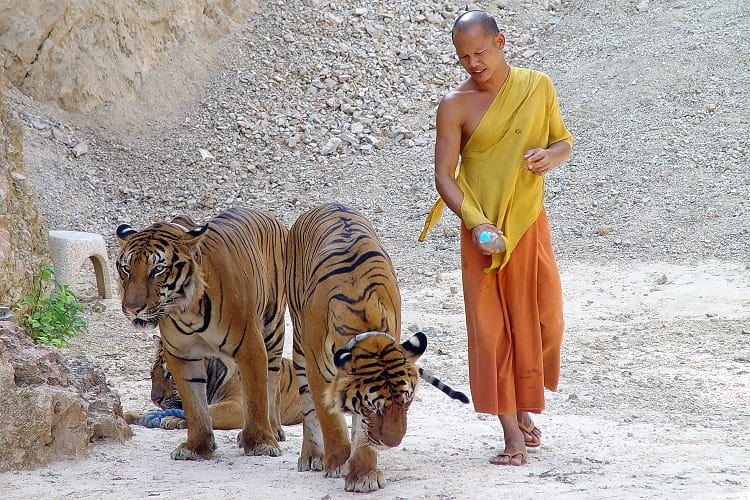
A monk walking tigers at the Tiger Temple in Thailand. (Michael Janich / Wikimedia Commons)
The Tiger Temple, also known as Wat Pha Luang Ta Bua Yanasampanno, was a Theravada Buddhist Temple located in Thailand’s Kanchanaburi province. It was established in 1994 as a forest temple and a sanctuary for Indo-Chinese tigers and other wild animals. The temple has been accused of mistreatment, abuse and trafficking of tigers by various animal rights groups since its establishment. Reports also suggest that the Tiger Temple served as a clandestine tiger-breeding facility, which is illegal in Thailand. Also, it violates the CITES (Convention on International Trade in Endangered Species) treaty to which Thailand is a signatory.
The initial success of the Tiger Temple
Initially, the Tiger Temple was a huge success and was internationally lauded because they claimed that the tigers were rescued from poachers. The Tiger Temple proclaimed that it offered a serene and peaceful natural environment for the Tigers to live in, cared for by the Buddhist monks serving the temple. All of these facts led to a massive influx of international and national tourists, who decided that the unique Tiger Temple was a must-visit destination. Also, the Tigers appeared to be increasingly docile and friendly, and the tourists could take photographs with them. Tourists also got the opportunity to cuddle tiger cubs, and nobody seemed to want to miss out on that.
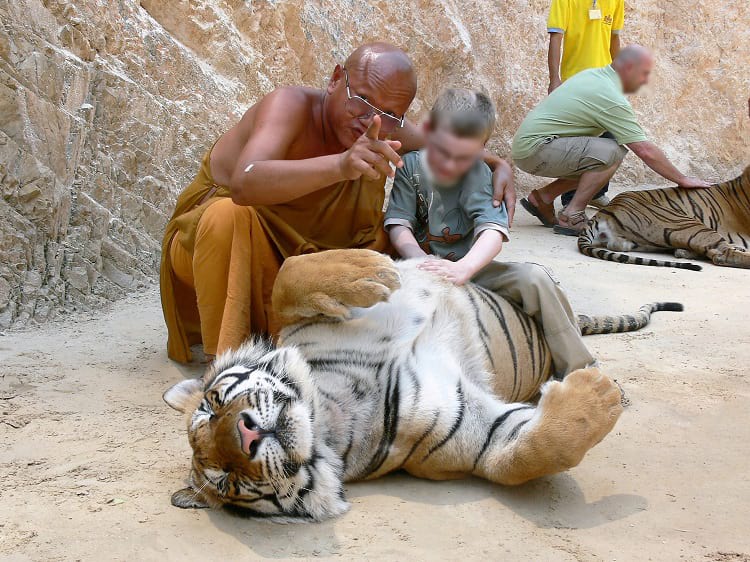
A child sitting on a tiger’s belly while a monk points towards the camera. (Kieran Lamb / Flickr)
Secret investigations
In 2005-2008, a British NGO Care for the Wild International (CWI) conducted undercover investigations into the conditions of tigers at the Tiger Temple. They unearthed ghastly evidence that the Tigers were regularly beaten with wooden sticks and clubs, were kept in unsanitary conditions with inadequate food, and were forced to sit out in the sun for too long. They also reported that when the Tigers were disobedient during photo sessions, the keepers sprayed their faces with urine. In the wild, tigers use urine to mark territory or to show aggression. Using this tactic to force the Tigers into submission was one of many heinous cases of abuse that the Tiger Temple committed. Later, it was theorised that the docility of the tigers was brought about by drugging them.

A monk sitting on a tiger inside the temple. (Kieran Lamb / Flickr)
Further investigations by CWI
In 2008, CWI released a complete report on the ongoing abuse of tigers at the Tiger Temple titled “Exploiting the Tiger”. The investigators found damning evidence of the Temple being used as an illegal breeding and trafficking centre of these endangered tigers. A copy of a contract was also unearthed where the Tiger Temple agreed to send tigers to an illegal tiger farm in Laos. The contract was signed by the tiger farmer, the Abbott (high priest), and a member of the Tiger Temple board. These actions break Thai, Laos and International Law all at the same time. In the name of conservation, tigers at the temple were abused for more than 20 years.
Litigation
In 2010, the Tiger Temple decided to sue Edwin Wiek, the founder of “Wildlife Friends Foundation of Thailand”, a conservation sanctuary located in Hua Hin. They decided to bring forth a defamation case against Edwin, and two others, over comments they made in the Thai Post, a Thai-language daily newspaper in the country. However, this lawsuit came to nothing, and all charges were dropped.
The investigation by the Thai government
After a lot of public outcries, the Thai government finally decided to investigate the reports of mistreatment and animal abuse going on at the Tiger Temple. On 2nd February 2015, Thai Forest officials conducted an official investigation of the Tiger Temple. Initially, they were refused entry and were not permitted to conduct their investigation. The next day, the officials returned with soldiers and a warrant and began to conduct their investigation. They discovered that the Tiger Temple also engaged in the breeding and trafficking of 38 species of protected birds. The forest officials also proceeded to impound the tigers until further investigations were completed.
Cee4Life and National Geographic reports
In early 2016, two reports spanning nine years of undercover investigation and research conducted by the Australian organisation Cee4Life were released to the public. The first Cee4Life report contained CCTV footage, recordings and witness statements regarding the regular unexplained disappearance of tigers from the Tiger Temple facility. The second report contained chilling evidence of the sale of tiger body parts, trafficking, gifting and international transport. Immediately afterwards, National Geographic also released a comprehensive report alleging that the monks at the Tiger Temple were abusing the tigers and were operating for-profit breeding, selling and exploitation business. Following these reports, the Thai government set into motion procedures to shut down the facility for good and to rehabilitate all the tigers and return them to wild. Tigers, being endangered animals, are considered state property in Thailand and breeding them without a permit is a violation of Thai Law.
In May 2016, the Thai forest officials started removing all the tigers from the facility. To their horror, they discovered forty tiger cub corpses preserved in freezers located in the facility. According to veterinarians working with the Forest Department, the tiger cubs had died only a short time before the raid. The temple had not reported any tiger cub births in months. This was the final proof that the Temple was exploiting tigers and breeding them for profit. The Abbott and other board members of the Temple are under investigation for smuggling and animal abuse.
Due to the selfless action of these animal rights activists, the Thai government was able to put a stop to this horrible industry.
Enjoyed this article? Also, check out “Tiger Farms: Where a Shady ‘Tiger Conservation Business’ Puts the Entire Feline Population at a Greater Risk“.
Fact Analysis:
STSTW Media strives to deliver accurate information through careful research. However, things can go wrong. If you find the above article inaccurate or biased, please let us know at [email protected].
 Recommended Read:
Recommended Read:
Tigers Forever: Saving the World’s Most Endangered Big Cat | By Steve Winter & Sharon Guynup
Genre:
Non-fiction > Nature
RELATED
The post Tiger Temple: A Clandestine Tiger-Breeding Facility Run by Monks appeared first on .
]]>The post Unit 731: Gruesome Human-Experimentation To Test Biological And Chemical Warfare In Japan During WWII appeared first on .
]]>
The main building of Unit 731. (Akiyoshi Matsuoka / Wikimedia Commons)

General Shirō Ishii. (Masao Takezawa)
Unit 731 started out as a research unit that investigated the effects of disease and injury based on the army’s fighting ability. Unit 731 was a covert biological and chemical warfare research undertaken by the Japanese Imperial Army. Their mode of research was human experimentation. The incident took place during the second Sino-Japanese war during the Second World War. The aftermath was the birthing of some of the most notorious war crimes in Japan. The Unit was commanded by General Shirō Ishii, a combat medic officer in the Kwantung Army.
Unprecedented ways of Unit 731
It wasn’t until 1984 that Japan finally acknowledged Unit 731 as a real, existing incident in their history. They released a list of survivors but they have tried to keep the episode under wraps as much as possible. There were several means of experimentations including vivisection, germ warfare attacks, frostbite testing and much more. These ‘lab rats’ were referred to as “maruta” which means wooden logs- apparently in an attempt to ease their conscience.
Frostbite testing: The Nightwalkers
Yoshimura Hisato was a physiologist who was assigned to Unit 731. He harboured a special interest in hypothermia whose fruition was seen in the experiments that he carried out. As part of the research, Hisato routinely submerged prisoner’s limbs into tubs of ice for long periods of time until their limbs had completely frozen over. It is said that the arms and legs sounded like a plank of wood when struck by a cane. Immediately after this, Hisato tried on different methods of rapid rewarming. He dipped the limbs in tubs of hot water for a very long time or held it very near to open fire. He even left the patients out overnight to see if the blood would thaw out naturally.
Vivisection: Split into two
Vivisection involves the practice of mutilating bodies without anaesthesia in order to study the operating living system. Thousands of men, women and children- especially Chinese prisoners- were infected with diseases such as the plague and cholera. They were then operated on and had their organs removed to be studied later. These experiments initially began with volunteers from the army itself but as consent flew out the window, the prisoners began to be used instead.
A medical assistant in China during this time narrated one such incident. He revealed:
“I cut him open from the chest to the stomach, and he screamed terribly, and his face was all twisted in agony. He made this unimaginable sound, he was screaming so horribly. But then finally he stopped. This was all in a day’s work for the surgeons, but it really left an impression on me because it was my first time”.
He explained how this practice came to be, and the Chinese were deliberately infected with plague to make plague bombs. Anaesthesia was not used since the chemicals might prevent reactions and hamper the ‘study’.
Weapon testing: To kill or not to kill
Prisoners were used to test out the skill and power of the weapons that were possessed by the Japanese. They were herded together in a firing range and were fired with ammunition such as the Nambu 8mm pistol, bolt-action rifles, machine guns, and grenades. Wound patterns were then compared. Bayonets, swords and knives were also used in this way along with gas chambers especially nerve gas and blister agents. Heavy objects were dropped on the prisoners to test crushing intensity. They were also locked up without food and water with permits to only drink sea water. Different fusions of blood were given to them to see the process of clotting.

An unidentified victim of Unit 731. (Jilin Provincial Archive)
There were innumerable other methods of torture apart from the ones already mentioned. Women were raped and forcefully impregnated, especially the ones who were infected with diseases. Their foetuses were cut open to study the effects. Unit 731 had about eight separate divisions that operated on different categories. They ran their lab at a medical school and research facility in Tokyo but their base was in the Harbin district. A similar establishment as this was the Unit 8604 running in Guangzhou.
Victims: Is surviving a gift or a curse?
Prisoners were also deliberately infected with the disease Syphilis. The effect of the disease was then monitored. No treatment was given to the prisoners. Sometimes these infected prisoners were forced to rape fellow male and female prisoners to monitor the transmission of the disease.
It is believed that a majority of the victims were Chinese, Korean and Soviet. There is, however, speculation about some of them being of American, European, Indian or Australian origins as well. These foreign test subjects were mainly political dissidents, communist sympathizers, ordinary criminals, impoverished civilians, or mentally handicapped.
Why do we not know about Unit 731?
The operations ran until the end of the war. General Ishii wanted to make use of the Unit even during the Pacific War. With the arrival of the Red Army and the occupation of the US, members of Unit 731 deserted their facility. They were surprisingly given war crime immunity by the Americans in return for information on experiments conducted. Not much information is available about this official Unit because the Japanese government never fully acknowledged it. Trickles of information have surfaced from willing former members, eventually accumulating into the sizeable chunk information we now possess about the Unit’s infamous practices.
It is baffling how incidents such are these are brushed under the carpet so easily. While Nazi human experimentation and other similar incidents have come to the forefront, innumerable others still remain in the shadows. The apparent progress of our species has in fact been leading to a humanitarian degeneration. As Edmund Blunden says, gruesome war crimes such as Unit 731 was ‘murder, not only to the troops, but to their singing faiths and hopes.’
Also, check out “1937’s Rape of Nanking is One of the Most Brutal and Forgotten Genocides of 20th Century“.
Fact Analysis:
STSTW Media strives to deliver accurate information through careful research. However, things can go wrong. If you find the above article inaccurate or biased, please let us know at [email protected].
RELATED
The post Unit 731: Gruesome Human-Experimentation To Test Biological And Chemical Warfare In Japan During WWII appeared first on .
]]>The post The Bengal Famine of 1943: The Man-Made Famine That Killed Around 3 Million Indians appeared first on .
]]>
Bengal famine,1943. (Unknown)
Between 1943 and 1944, while the Second World War was at its peak, a terrible famine ravaged Bengal and several other provinces in British India. The British government’s deliberate policies of ignoring the situation and not providing adequate relief measures exacerbated the situation. Over 3 million people died from starvation, disease, and other causes arising from this largely man-made famine.
The Bengal famine of 1943
A traditionally agrarian nation, India has faced famines throughout its long history. You will find mentions of these in many ancient folktales, epics, and other cultural instances. For the most part, these famines occurred due to natural events—lack of sufficient rainfall, a late Monsoon, pest infestation, and so on. Warfare and epidemics also often contributed to the famines.
Local rulers, however, usually managed to keep things from spiralling out of control. They had famine relief measures in place and these prevented mass starvations and deaths. Farmers could count on the rulers’ support in terms of decreased taxes and seed supplies from the state granaries.
To give an example, during the Mughal era, the Mughal emperors charged a 10-15% tax on the peasants. The grain they took from them was stored in the Mughal granary and, in times of difficulties, the government used this grain to sustain the population. So, if crops failed, the peasants always had a safety net they could depend on.
They lost this safety net after the British seized power from the Mughals. First of all, the British raised the taxation to 50%, and their main concern was with amassing a fortune for themselves. The condition of the peasants or the rest of the population didn’t trouble them too much. When the Bengal famine of 1769-1773 occurred, the government provided no relief at all and stood by as around 10 million people died. In fact, the British then proceeded to only increase the taxation to make up for the revenue lost due to the deaths of the farmers. So, in brief, the survivors were practically punished for surviving and had to work twice as hard to pay the taxes that their dead brethren would have paid.
In 1943, the situation wasn’t vastly different.
India was still a largely agrarian economy with the majority of the population living in rural areas. The province of Bengal, in particular, depended on agriculture, and large tracts of it was under rice cultivation. Rice was the principal crop of Bengal—as a government report on the famine later stated, it was a province of rice growers and rice eaters. The farmers grew three crops of rice per year and the winter crop was usually particularly bountiful.
In 1942, however, the winter crop failed, ravaged by a widespread outbreak of brown spot fungal disease. Plentiful rain that year, accompanied by cyclones and storms, contributed to the spread of the fungus. The crop failure was certainly a principal factor leading to the Bengal famine of 1943.
Additionally, the soil fertility was in decline and contributed to poor crop yields.
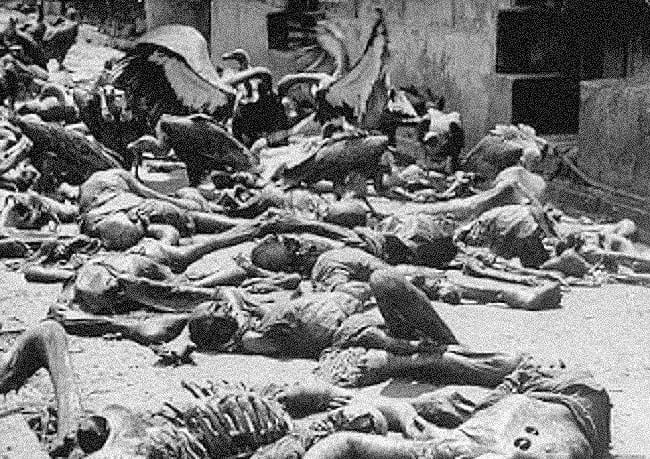
Vultures feeding on human remains during the famine. (Wallace / Wikimedia Commons)
Other factors contributing to the Bengal famine of 1943
Apart from natural reasons, let’s look at some of the other factors that led to the famine:
Socio-Economic factors
In 1943, Bengal was still a semi-feudal land, but the strictly drawn social boundaries were starting to unravel. The zamindars, who had traditionally been at the top, were losing their power, while the jotedars were gaining ascendency as landowners and usurers. The peasants, meanwhile, toiled on their meagre parcels of land and remained at the bottom of the social order. In fact, many of them saw their situation deteriorate further.
The grinding poverty forced them to take out monetary loans from the jotedars to meet even their basic daily needs. The jotedars charged them high interest rates for these loans, which essentially ensured that the peasants would never be able to repay the loans and would remain forever impoverished and in debt bondage. Many of them forfeited their lands and had to work as landless labourers on other people’s farms.
The peasant class was the worst hit and suffered the most during the Bengal famine of 1943.

A woman aiding a starving man. (Unknown)
The Second World War
The on-going war disrupted communication and transport. The British seized boats and barges that could have been used to transport food and burned them. This was done to prevent these vessels from being captured by the advancing Japanese. However, the policy prevented Indian farmers from transporting their harvest and led to monetary losses. It also prevented food from reaching the starving population.
Furthermore, wartime speculation and hoarding of rice stocks also contributed towards the famine.
The Japanese attack on Burma
In the normal course of things, the British government could have imported rice from neighbouring Burma for Bengal’s starving population. However, the Japanese advance and takeover of Burma prevented that.
The Quit India movement
The Indian National Congress, under Gandhi’s leadership, launched the Quit India Movement in 1942. While it was meant to be a non-violent mass resistance against the British, the arrest of the Congress leadership led to violent incidences throughout the country. Due to the efforts of the Indians to jeopardize the British war effort by sabotaging bridges, factories, trains, and so on, the British adopted a hardened and violent stance towards the population.
Governmental failure
As was the case in the 1700s, the British government followed a callous and unconcerned policy.
It would have been possible to alleviate the plight of the starving people and prevent millions from dying. The harvest in the rest of the country had been good and it would have been possible to send enough rice to Bengal to sustain its population. However, the British were more interested in supporting their war effort than in providing relief to the famine-struck province.

Malnourished orphans that survived the famine. (Bengal Speaks)
The food supplies that could have fed the starving Indian populace were diverted, instead, to feed the civilians in the UK and the British soldiers engaged in the war in other parts of the world.
In the British parliament, Prime Minister Winston Churchill ignored or turned down all official requests to import food to Bengal. He had no liking for Indians and, at one point, declared that it didn’t matter if they died since they seemed to breed like rabbits anyway. He inquired that if the famine was bad as everyone said, why was Gandhi still alive?
The British government also turned down offers from Canada and the USA to send food supplies to Bengal.
When the government did finally stir into action, the relief policies they implemented were inadequate and too late. The government then appointed a famine inquiry commission to investigate why the famine happened and make recommendations to prevent future famines.
The effects of the Bengal famine of 1943
Over three million people died in the famine. People lost their families, their homes, and their livelihoods. Diseases like typhoid, cholera, and malaria took a further toll of the population. Farmlands lay deserted and turned into wastelands. The tragedy rent the entire social fabric of Bengal, and the state took a long time to recover economically. As a result of the British government’s hard-hearted policies, the Indian freedom struggle gained further momentum.
Writer’s Opinion
Let us be clear about the causes of this famine. While natural factors certainly played a role, it was mainly a man-made famine. Except for the British government’s callous to the point of criminal conduct, it could have been possible to stave off the famine and save the millions that died. It is unfortunate that in modern-day India very few still remember this entirely avoidable tragedy.
Also, check out “The History of Breast Tax and the Revolt of Low Cast Women in 19th Century Travancore“.
Fact Analysis:
STSTW Media strives to deliver accurate information through careful research. However, things can go wrong. If you find the above article inaccurate or biased, please let us know at [email protected].
RELATED
The post The Bengal Famine of 1943: The Man-Made Famine That Killed Around 3 Million Indians appeared first on .
]]>The post Rape of Nanking is One of the Most Brutal and Forgotten Genocides of 20th Century appeared first on .
]]>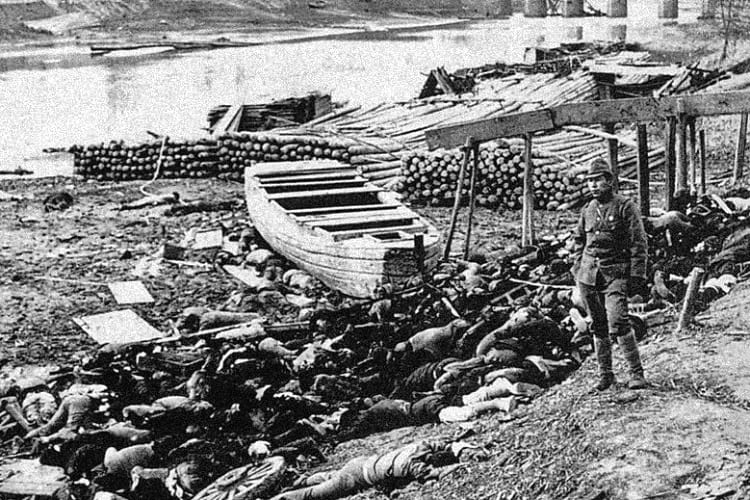
Dead bodies lying on the bank of Qinhuai River during Rape of Nanking Massacre. (Originally Moriyasu Murase)
History is full of Holocaust -i.e., Hitler’s Nazi Germany committed an act of genocide by killing six million Jews across Europe. This happened between the World War II years of 1941 and 1945. But does history speak of the Rape of Nanking in the same breath? Probably, no.
The Rape of Nanking is one of the most brutal acts of 20th-century genocides of world history that took place in December of 1937.
The invading Japanese ran over Nanking, which was the capital of China at that time, butchering at least 300,000 Chinese civilians and raping 20,000 to 80,000 women. All this happened in a matter of just eight weeks.
As part of the sack of Nanking, the Japanese went on to torture hundreds of thousands of civilians in the Chinese capital.
Journalist Iris Chang wrote a book
Disturbed over this genocide, journalist Iris Chang wrote a book in the subject titled ‘The Rape of Nanking: The Forgotten Holocaust of World War II’. It was published by Basic Books.
It is through this book the modern world came to know of the gory details of the Japanese atrocities in Nanking, China. Until then only a handful of survivors and some others knew about the Rape of Nanking.
Iris Chang claims that Nanking was a laboratory for Japanese soldiers, where they were taught to slaughter unarmed and unresisting civilians. Later, the Japanese are said to have used similar tactics elsewhere in Asia.
Japan failed to acknowledge the genocide
Till today, the Japanese have not acknowledged the genocide. Obviously, the Japanese government is therefore yet to pay reparations to the Chinese for its army’s actions.
The Second Sino-Japanese War
The Imperial Japanese Army marched into Nanking in December 1937, at the peak of the second Sino-Japanese war. Nanking was the then Chinese capital city. (Today Nanking is known as Nanjing) As per historical records, the city was virtually undefended. As a result, soldiers of the Imperial Japanese Army swept through the city killing, raping and torturing thousands of civilians.
The city was devastated after a six-week spree of violence. The International Military Tribunal for the Far East concluded that thousands of Chinese women were raped during the first month of the Japanese occupation.
Before the war
Decades before the genocide, tensions were building up between the Japanese Empire and the Republic of China. These tensions had led to the First Sino-Japanese War between the two in 1894 and 1895 over the Korean Peninsula. At that time the Qing Dynasty was ruling over China.
The Japanese Empire feared the Qing Dynasty’s military presence in Korea. It felt whoever held Korea could control Japan. Japan declared a state of war and annexed the Korean Peninsula from China.
Later, the Russo-Japanese War took place from 1904 to 1905. The two empires fought over the Russian influence over the Korean peninsula and Manchuria. The war came to an end following a treaty which gave Japan official control of Korea and South Manchuria.
After the end of World War I, also known as The Great War, the era of prosperity ended the world over including Japan. To prevent mass starvation following the global economic depression, ultra-nationalists forced the Japanese government to conquer newer territories.
It is in this context, Japan declared war against China and started bombing Nanking from August 15, 1937, onwards. As a result, millions of Chinese turned refugees. They fled the city either by land, boat or train.
Japanese troops first attacked Shanghai
At the same time, the Japanese troops first attacked Shanghai before moving on to Nanking. At Shanghai, the Chinese troops gave strong resistance. Both sides suffered heavy casualties. By November, however, the Japanese captured Shanghai.
Even before the Japanese headed towards Nanking, the Chinese government left for relocation. The then president Lin Sen left the city and left its fate John Rabe, who was the head of the Nazi Party in Germany.
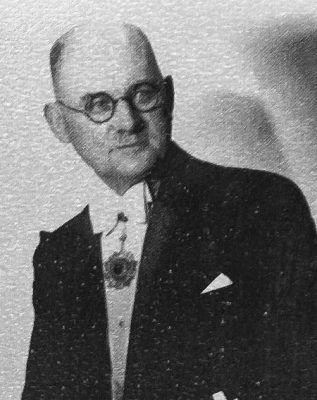
John Heinrich Detlef Rabe. (DrSivle / Wikimedia Commons)
Meanwhile, the Japanese army unleashed their acts of crime on their way to Nanking. They started clubbing, bayoneting Chinese citizens and abducting and raping Chinese women and throwing them into sexual slavery.
Safety Zone in Nanking
Worried over atrocities on the Chinese, a handful of Europeans and Americans formed an International Committee to create a Safety Zone in Nanking. The foreigners had decided to stay put in Nanking and help the Chinese.
As part of the Safety Zone, a small portion of the Nanking city was partitioned off. The area of the safety zone was just two and a half square miles. Within the zone, non-Chinese as well as Chinese were off limits to the invading Japanese forces.
Interestingly, John Rabe struck a truce deal with the Japanese for the safety of Chinese soldiers within the Zone. As per the truce, the Japanese Army to also treat the Chinese soldiers as POWs. But, the Japanese put to death thousands of Chinese – soldiers and civilians alike.
Japanese troops attacked Nanking before dawn
On a fateful day, December 13th, 50,000 Japanese troops attacked Nanking before dawn. Even though the 90,000 Chinese troops outnumbered the Japanese, they collapsed after the enemy deceived and killed them across Nanking.
Throughout the siege of Nanking, the Japanese used Chinese soldiers and civilians for bayonet target practice. Though the massacre was carried on for months, the worst atrocities took place in the first eight weeks itself.
During this period, one could see several beheaded corpses of Chinese victims on the shore of the Qinhuai River that passed through Nanking city. According to writer and journalist Iris Chang, during the massacre, the Japanese army officers inculcated the soldiers to kill. This happened throughout Nanking. As a result, the Japanese soldiers brutally killed people.
Chinese women used as ‘comfort women’
The Japanese soldiers indulged in live burials and killing of women after raping them and using them as ‘comfort women’. Almost 50 years later such women broke their silence and asked the Japanese government for financial compensation. It is not known whether they received the compensation or not.
Swiftly, the Japanese took control of the city and also started to regulate the activities inside the safety zone. In spite of their efforts to eliminate the safe zone, the Japanese failed to do so. Eventually, the zone housed almost 700,000 refugees.
Censorship imposed
Meanwhile, the Japanese imposed a state of censorship over the safe zone. They made attempts to cover up atrocities across Nanking, moderated letters, journals, photos and moving images.
Between March and July of 1938, the genocide was over. The Japanese continued to occupy Nanking through World War II and until they surrendered.
International Military Tribunal
Later in December 1946, after a lengthy trial within the International Military Tribunal for the Far East War, Lieutenant General Tani Hisao of Japan was indicted as a war criminal. On March 10, 1947, he was sentenced to death.
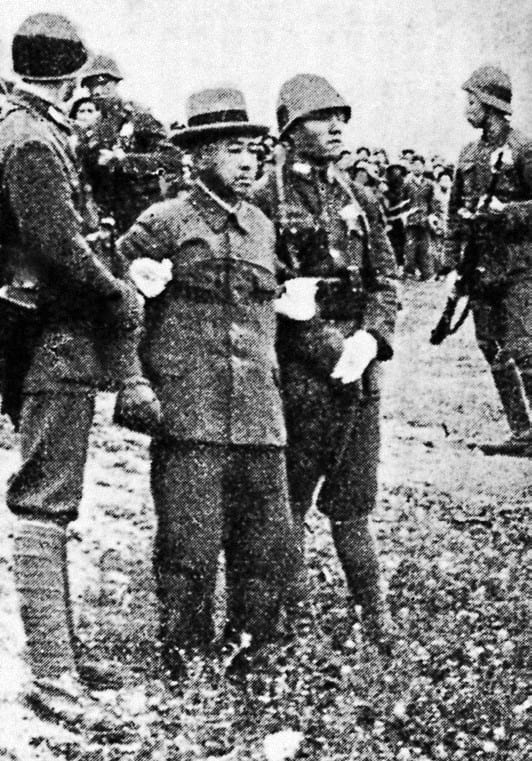
Tani Hisao being escorted for his execution, 1947. (Unknown)
At the same time, the Chinese War Crimes Tribunal convicted three other Japanese officers and sentenced them to death. The officers were Captain Tanaka Gunkichi, Lieutenant Noda Tsuyoshi and Lieutenant Mukai Toshiaki.
Meanwhile, the Tokyo War Crimes Trial charged Commander Matsui Iwane as a Class A war criminal. He was indicted on 29 counts. Further, the former Japanese Foreign Minister Hirota and six others were also found guilty as Class A war criminals. They were hanged to death.
Japan destroyed many records
Sadly though, not many records from the Japanese side were available for the war tribunals, because they were destroyed by Japan in 1945. With the result, the prosecutors, as well as the historians, later failed to get accurate details of the Nanking massacre.
In view of these conditions, even today the genocide continuous to remain a contentious political issue between China and Japan. The Japanese government, as well as the civil society to some extent, denies that the 1937 massacre was genocide.
Killing contest held by two Japanese officers during Rape of Nanking
Perhaps, one of the most notorious atrocities committed in Nanking was the killing contest held by two Japanese officers. As news reports of that era indicate, there was a contest between the two officers to see who could kill 100 Chinese first with a sword.
According to unconfirmed news reports, Prince Asaka, who was the Japanese commander at that time, had a role in the Nanking massacre. After the genocide, Nanking took several decades to recover and later grew into a modern industrial city. Today it is home to China’s largest state-owned companies.
Enjoyed this article? Also, check out “Masada, Israel: Did 967 Rebellious Jews Really Commit Mass Suicide Here?“
Recommended Read:
The Rape of Nanking: The Forgotten Holocaust of World War II | By Iris Chang
Fact Analysis:
STSTW Media strives to deliver accurate information through careful research. However, things can go wrong. If you find the above article inaccurate or biased, please let us know at [email protected].
RELATED
The post Rape of Nanking is One of the Most Brutal and Forgotten Genocides of 20th Century appeared first on .
]]>The post The History of Breast Tax and the Revolt of Lower Cast Women in 19th Century Travancore appeared first on .
]]>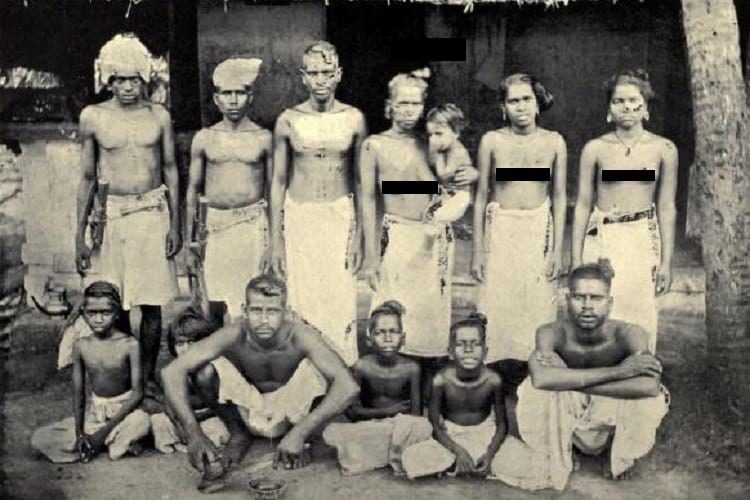
Censored Photo: A Thiyya/Tiyya family, 1900s. (Edgar Thurston)
Throughout history, kings and governments had imposed some weird taxes. You may have heard of a Bachelor Tax, a Cowardice Tax or even a tax on beards. But have you ever heard of a tax on a woman’s breast? Believe it or not, such a tax was imposed on women of lower caste in Kerala during the early 19th century.
The breast tax or locally known as Mulakkaram, which was prevalent in the Travancore Kingdom, was imposed on Dalit and backward class women. It was especially slapped on Avarna women, who belong to the lower caste.
These women were forced to pay a tax on their breasts if they desired to cover their breasts with an upper cloth. In those days, women of low cast baring their breasts were considered as showing respect to superior castes like the Namboodiris (Brahmins).
During the reign of Balarama Varma I
During the reign of Balarama Varma I (1798–1810), Queen Gowri Lakshmi Bayi (1810–1815) and even Uthradom Thirunal Marthanda Varma II (1846–1860) Breast Tax were prevalent. Both men and women of the lower castes like the Ezhava and Nadar communities were not permitted to cover their chests before members of the upper caste.
As the caste system in Kerala of that time was oppressive, people of the lower castes were not entitled to wear any upper cloths. Upper cloths were a sign of prosperity and wealth in those days.
Writing in his book, ‘Native Life in Travancore’, author Samuel Mateer claimed that lower castes were burdened with taxes and remained in debt and poverty. Whereas, the upper caste people like the brahmins and the Nairs prospered.
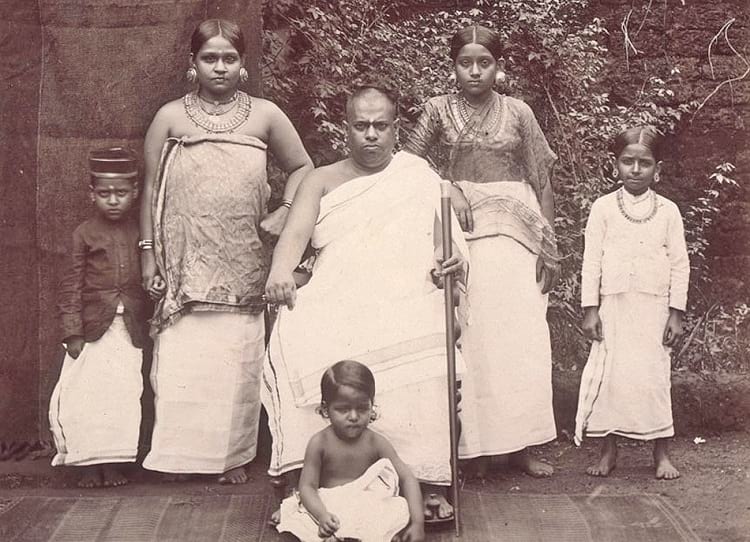
A Brahmin family in Kerala, 1902. (Clain and Perl studio, Madras)
Nair women were also not permitted to cover their breasts
According to an article, Travancore officials would visit every house to collect Mulakkaram from any low caste women who passed the puberty age. There also reports that claimed the tax amount depended on the breast size.
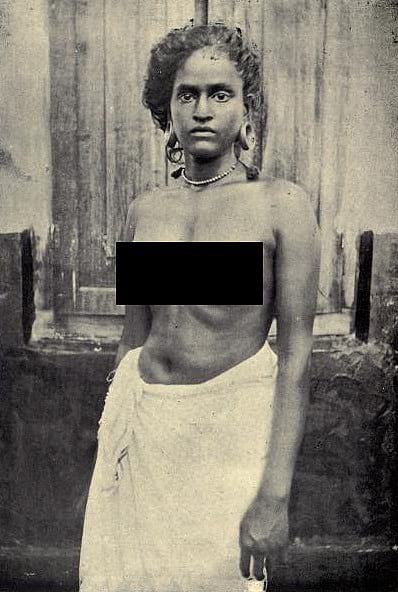
Censored Photo: A woman from a lower caste in Kerala. (Edgar Thurston)
However, it is interestingly to note that Nair women were also not permitted to cover their breasts while entering temples or in front of the Brahmins. There was, therefore, all-around oppression of the people of the lower caste in the Kingdom of Travancore.

Nair Women, circa 1914. (Clain and Perl studio, Madras)
Namboodiri women could cover their breasts
In total contrast to the lower caste woman, Namboodiri women could cover their breasts with an upper cloth. These women were, however, mostly confined to the inner rooms of their homes. Hence, they were known as antharjanam.
Namboodiri women could not talk to anybody except to their husbands and immediate families. On a rare occasion, when they are allowed to go out they were to cover their face with a palm umbrella.
Writing a book on Nair women, R Raman Nair and L Sulochana Devi said when a Nair woman with an upper cloth appeared before the Zamorin, her breasts were chopped off. R Raman Nair and L Sulochana Devi’s book is titled “Chattampi Swami: An Intellectual Biography”.
The rise of the Syrian Christian or Roman Catholic communities
The early 19th century also witnessed the rise of the Syrian Christian or Roman Catholic communities. In 1813, during the reign of Queen Gowri Lakshmi Bayi, Colonel John Munro was the Dewan of Travancore court.
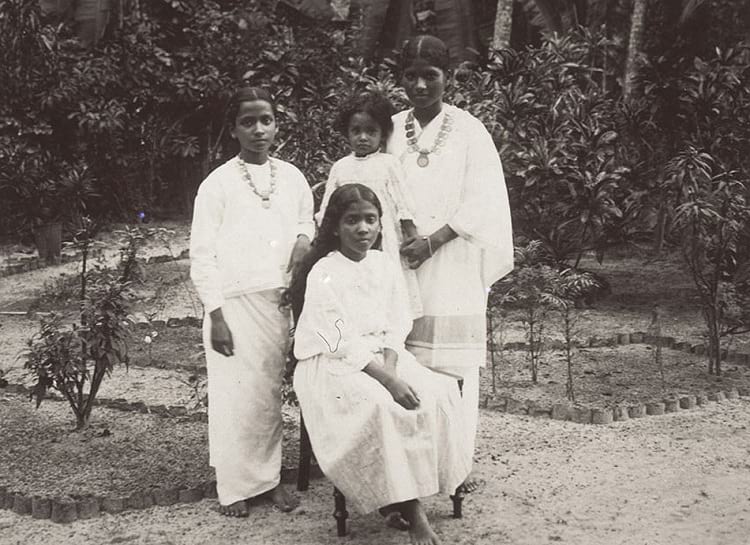
Syrian Christian women in Kerala. (Clain and Perl studio, Madras)
In his bid to propagate Christianity and gain the confidence of the Nadars, Colonel Munro proposed a solution to the oppressive Breast Tax. As Dewan, he issued an order saying that if Nadars convert to Christianity their women can cover their breasts with upper cloth.
This order irked the Queen and her court. Their protests went partially unheard. As a result, the Nadar women were since then permitted to wear a long blouse similar to the Syrian Christians and the Muslims.
Converted to Christianity
Later, however, to escape the royal oppression lower caste people increasingly converted to Christianity to lead an honourable life. Since then women Christian converts had the freedom to cover their breasts with kuppayam or outer cloak.
Yet, the upper castes denied permission to Christian Nadar women from wearing an upper-cloth similar to the Nair women. The Nair women had the privilege of wrapping a cloth around their torso in a particular style.
The idea was to retain caste hierarchy
The idea was to retain the hierarchy between the two communities in a distinct manner. But Christian Nadar women rose in protest. They demanded that they are permitted to wear a cloth similar to the Nair women. With the increasing influence of Christianity, resentment started growing against the upper castes. Following which violent clashes took place across the Travancore kingdom.
Channar Revolt
These protests and clashes came to be known as the Channar Revolt or Channar Lahala. The revolt was also known as Maaru Marakkal Samaram. During the violence that followed, low caste women who wore upper cloth or blouse were stripped naked. Churches and houses of low caste people were also raised to the ground.
According to the book “Religion and Social Conflict in South Asia”, following the intervention of the then British governor located at Madras, the Kings of Travancore issued two proclamations. The first was in 1859. It was issued by Maharaja Utram Thirunal. The second was issued by Maharaja Ayilyam Thirunal in 1865.
Proclamations abolished the Breast Tax
Both the proclamations abolished the Breast Tax and lifted all restrictions on wearing the upper cloths. But these proclamations came too late.
The bravery of a low caste woman named Nangeli
Because, in 1803 the bravery of a low caste woman, named Nangeli, turned symbolic of the struggle for the upper cloth. She belonged to a village called Cherthala in central Kerala. In that 19th century year, Nangeli ferociously defied the tax collector, who reached her house to collect the breast tax.
When the tax collector exerted pressure on her, she unflinchingly chopped off her breasts and placed them on a banana leaf in front of the tax collector. She eventually bled to her death. On coming to know of this, Nangeli’s husband too committed suicide.
Later, the land where she stayed was named Mulachiparambu, simply meaning ‘the land of the breasted woman’.
No mention in the official history of Kerala
Though the story of Nangeli’s sacrifice spread across the state, it has no mention in the official history of Kerala.
The upper cloth mutiny can be considered as one of the pioneering struggles for the liberation of women in the whole of Kerala. Writing on the impact of the revolt in his book titled ‘Vaikuntaswamiyum Samoohika Navothanavum’, historian Joy Balan Vlaathangara said this revolt triggered more agitations across the state.
Some of the other agitations were for the right to walk on public roads, entry into temples and against oozhiyam vela (work without pay). As a result, the face of Kerala changed for the better. It is also sad to note that CBSE deleted a section on Kerala’s caste history in its social science textbook.
Also, there is no mention of the breast tax in the book ‘A Hundred Years in Travancore, 1806-1906: A History and Description of the Work Done by the London Missionary Society in Travancore, South India, During the Past Century’. This is a reflection of the official apathy towards a revolt that changed the very caste structure of Kerala today.
Enjoyed this article? Also, check out “In Tsarist Russia Members of the Secret Skoptsy Sect Believed in Self-Castration“.
Fact Analysis:
STSTW Media strives to deliver accurate information through careful research. However, things can go wrong. If you find the above article inaccurate or biased, please let us know at [email protected]
RELATED
The post The History of Breast Tax and the Revolt of Lower Cast Women in 19th Century Travancore appeared first on .
]]>The post Project MKUltra: CIA’s Cold War Conspiracy to Secretly Control Human Mind Goes Wrong appeared first on .
]]>
Memorandum for the record of Project MKUltra. (Wikimedia Commons)
On April 13 of 1953, the Central Intelligence Agency (CIA) of the United States took up an experiment named Project MKUltra with the help of 150 civilian Americans.
As part of Project MKUltra, the CIA is said to have used certain substances on these civilians to study the impact on their mind. The project, therefore, is known as a mind control programme, according to Brionne Frazier of the website www.thoughtco.com.
The project had no executive sanction and as such, it was clandestine and hence illegal. In fact, the executive had no knowledge of the project until after 20 years. Experiments under Project MKUltra began in 1953 and ended in 1973.
Torture and interrogations
Designed and executed by the CIA’s Scientific Intelligence Division, the experiments on civilians were to identify and create drugs for use in torture and interrogations. The idea was to weaken an individual’s mind and extract confessions from him.
The SID coordinated with the U.S. Army’s Chemical Corps’s Special Operations Division in the highly controversial mind control programme.
Lysergic acid diethylamide, known as LSD, is a hallucinogenic drug. Swiss scientist named Albert Hofmann was the first to synthesize the drug in the 1930s.
Cold War
The CIA got interested in the drug during the Cold War and it used LSD and other drugs in secret experiments as part of its mind control programme. Before that, small doses of LSD were being used for medicinal purposes.
According to a book titled ‘The Interrogation Rooms of the Korean War: The Untold History’, the CIA took up Project MKUltra during the Cold War period. The reason: the US government was afraid of the North Koreans, Soviets and Chinese. The book’s author Monica Kim believes these three nations used mind control tests to brainwash American PoWs in North Korea.
CIA director Allen Dulles
In his desire to retaliate against the North Korean experiments, the then CIA Director Allen Dulles sanctioned funds for Project MKUltra. He wanted to use this covert operation to find new mind control techniques for use against the Soviet bloc. He wanted to control the behaviour of these enemies with the help of drugs and other mind manipulators.
Allen took over as the CIA chief on April 10, 1953, i.e. just days before the launch of Project MKUltra. At that time global tensions were high. Commenting on the state of mind of the GIs returning after the Korean War, the Soviets had played a sinister battle over men’s minds. He said this was a new form of Soviet’s brain warfare. Obviously, his words terrified the American people.
Conspiracy theories
The CIA is plagued with conspiracy theories. While some may be true, most are nothing but wild speculations. Perhaps, Project MKUltra could possibly be an ethically true conspiracy theory. According to Scotty Hendricks of www.bigthink.com, the CIA project had violated the Nuremberg codes and therefore it was illegal.
As part of Project MKUltra experiments, CIA MKUltra manipulated several civilians’ mental state. They used the drugs and chemicals to hypnotise the subjects and deprive them of their sensory perceptions. They even experimented in isolating the subjects and abuse them both verbally and sexually.
Various other forms of torture were also used.
The scale of Project MKUltra experiments
CIA did not concentrate its Project MKUltra experiments in one place. The experiments were across 80 institutions, including 44 universities and colleges. Some of the other institutions were the experiments took place include pharmaceutical companies, hospitals and prisons.
The CIA used these institutions as front organisations. As the experiments were done in secrecy, not many people knew that the CIA was behind them. Only a handful of top officials at these organisations knew of the agency’s role.
In the name of Project MKUltra, the CIA extended funds to universities like Columbia, Stanford and others to study the effects of the drugs. After some tests were done, researchers found that the drugs in question were highly unpredictable and cannot be used in counterintelligence activities.
These researchers used drugs like ecstasy (MDMA), heroin, mescaline, barbiturates, psilocybin and methamphetamine.
Operation Midnight Climax
In addition to experiments in universities and colleges, the CIA tried to lure gullible men safe drug houses with the help of prostitutes. They were then subjected to drug experiments under the now infamous Operation Midnight Climax.
These unsuspecting men were administered LSD in cocktails under a party-like atmosphere. CIA then secretly recorded changes in these men’s behaviour. These gullible men were mostly from cities like New York City, California, Marin County and San Francisco.
Almost all the Project MKUltra experiments were the direction of Sidney Gottlieb, CIA’s expert on chemicals, drugs and poison. Sidney was sure that CIA will succeed in finding the right drug that could alter any mind for the purpose of brain controlling.
Volunteers
However, Sidney slammed the experiments as “useless”. He felt the experiments had failed to produce satisfactory results.
Interestingly, CIA agents experimented with drugging one another at work or at weekend retreats. According to Libby Coleman’s article in www.ozy.com, such CIA LSD trips turned into workplace hazard. They even took the life of at least one person and it was considered as a suicide.
Also, there were some who volunteered for the Project MKUltra experiments. One of them was an author named Ken Kesey. He was a Stanford University student at that time. He later shared his experiences in his book One Flew Over the Cuckoo’s Nest.
There was also speculation that a person known as Unabomber (Ted Kaczynski) was part of the experiments at Harvard University.
Counter-productive
By and large, the Project MKUltra experiments were termed by some as counter-productive. One world famous personality who slammed the CIA experiments was John Lennon. In an interview, John mocked the CIA saying that people forget to thank the agency and the army for introducing LSD to Americans.
He further said, to control people the two organisations invented LSD.
In 1963, a member of CIA’s Inspector General’s staff, John Vance, chanced upon Project MKUltra. Following which the independent audit board of the agency insisted CIA should follow new research ethics guidelines.
Congress investigated Project MKUltra
Then in 1977, Senator Edward Kennedy ensured that the Congress investigated Project MKUltra. Congress interrogated ex-CIA employees on the LSD experiments. The investigation revealed several disturbing facts, including the 1953 suicide of Dr Frank Olson.
Dr Olson was a US Army scientist. He jumped out of a window after consuming LSD. However, during the hearings, the US Congress faced roadblocks. One major problem was the destruction of all key Project MKUltra files except for some.
The surviving 20,000 pages of documents survived as they were misfiled.
Then under the guidance of the Congress, a Church Committee examined the surviving documents. Following which, successive US Presidents Ford, Carter, and Reagan ordered the banning of all future experiments
Project violated the Nuremberg codes
Project MKUltra clearly violated the Nuremberg codes. And the real extent of psychological damage is still impossible to ascertain.
It is interesting to note that there are two Netflix series titled ‘Wormwood’ and ‘Stranger Things’ that deal with issues related to Project MKUltra and other secret CIA programmes.
Project MKUltra is thus a serious thought of what science can do if given a free hand.
Enjoyed this article? Also, check out “Unit 731: Gruesome Human-Experimentation To Test Biological And Chemical Warfare In Japan During WWII“.
Fact Analysis:
STSTW Media strives to deliver accurate information through careful research. However, things can go wrong. If you find the above article inaccurate or biased, please let us know at [email protected].
RELATED
The post Project MKUltra: CIA’s Cold War Conspiracy to Secretly Control Human Mind Goes Wrong appeared first on .
]]>The post In Tsarist Russia Members of the Secret Skoptsy Sect Believed in Self-Castration appeared first on .
]]>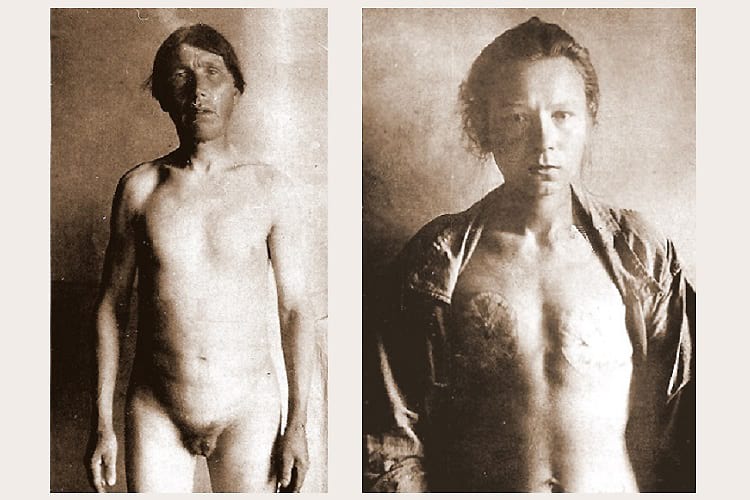
Castrated Skoptsy-man and -woman. (Wikimedia Commons)
In 1772, Christian clergy located in the former Orel Province of Russia came to know of the emergence of a new unorthodox sect in the region. Members of this heretical sect called themselves as Skoptsy or the Self-Castrators.
The unique feature of this sect is to surgically remove all their genital organs or part of them. Both men and women are ordained to go through this gruesome ritual. The word Skoptsy is a derivation of the outdated term ‘oskopit’, which means “to castrate”.
The new sect had separated from another sect called Khlystovshchina (Christ-Faith) or Khristovshchina (People of God). The later sect also had broken away from the Old Believers, a priestless religious community during the 1600s.
The leader of the Skoptsy sect
Interestingly, members of the sect called themselves with names like ‘God’s Lambs’ and ‘White Doves’. The leader of the Skoptsy sect is said to be a runaway peasant named Kondraty Selivanov. Until he joined the sect, Selivanov wandered across the Russian countryside avoiding the imperial authorities.
A woman named Akulina Ivanovna was leading the ship when Selivanov joined the sect. Akulina announced that he was the Son of God. Selivanov had a compelling influence on new converts who were ready to castrate themselves for the sake of salvation and purity. The converts believed Selivanov was the Otetslskupitel, Father-Redeemer.
It is, therefore, surprising that membership of the Skoptsy sect belonged to all classes of the society including civil servants, Nobles, merchants, military officers and finally priests.
The tsarist regime is believed to have found the Skoptsy sect most repugnant as it was an unkindly deviation from Russian institutional Orthodoxy.
Interestingly though, the sect existed till the beginning of the 20th century.
Skoptsy belief
The Skoptsy people believed that originally man and woman, before Adam and Eve, came into existence without the sexual organs. They considered the human genitals as organs of sin. As such, they believed in the practice of castration for gaining religious piety.
Also, they believed that the world would be transformed thanks to the disaster predicting religious communities.
Skoptsy people also believed that the main evil of the world is located in the lepost, which means sex appeal, bodily beauty and human sexuality. Lepost, therefore, is the one that prevents people from communicating with the Almighty. These people further believe that castration is one way of liberating the soul.
It is, however, interesting to note that the Skoptsy people never fully condemn the concept of marriage. Some of the sect members were permitted to have one child.
Dostoyevsky’s novels
While writing on the apocalyptic religions like Skoptsy in his novels, Russian novelist Fyodor Dostoyevsky said such religions can deepen discussions on queer temporality.
In fact, he wrote, the apocalyptic religions may provide a contrasting point to arguments that the future is the realm of an existing reproducing subject in imperial Russia.
Members of sects like that of Skoptsy generally gathered in small secret congregations called “ships”. A preacher, calling himself Christ, led each ship. Each congregation then selected a female sect member as the Mother of God. The sect members gave up sex, profanity and alcohol.
When the activities of the Skoptsy people came into light, a group of powerful Russian officials and the Christian Church ill-treated the sect members.
However, there was no major impact on the sect members, because they spread far and wide through Russia. Most of the Skoptsy people were illiterate provincial peasants. In their heyday, there were lakhs of Skoptsy people in imperial Russia.
Skoptsy people escape trial
But, the powerful leaders and the clergy captured Selivanov and exiled him to Siberia. Later, Russian Emperor Paul released Selivanov. After that Emperor Alexander I gave permission to him to reside in St. Petersburg undisturbed. In 1820, due to old age, Selivanov was taken to the monastery of Suzdal, where he died at the age of 112.
In 1800s several Skoptsy sect members escaped to Romania to avoid trial. In 1930, there were at least 2000 Skoptsy believers in Russia.
The Soviet Russian Skoptsy is believed to have ended in 1962.
Castration widespread across civilisations
It is strange but true that the practice of castration was widespread in quite a few civilisations in the past. As per archaeological records at the Neolithic town of Çatalhöyük, in the southeastern Anatolia region of Turkey, the practice of castration was common in the worship. Such practices took place even during 7500 BC.
It is also believed that Roman followers of Cybele, called the Galli, were also practising self-castration.
Historical records reveal that such practices continued during the Christian times encouraging ascetics like the Origen of Alexandria to castrate self. It is believed, scholar Origen had found scriptural justification in castrating self.
According to him, Matthew’s Gospel, verse 19:12 justified castration.
‘Anti-sexuals’ in Russia
It is believed that there are no more Skoptsy people in Russia or elsewhere. There are, however, some rumours that claim the existence of the sect’s followers in that country. However, an activist names Mirra clarifies that Russia today has at least 2000 ‘anti-sexuals’ and not Skoptsy followers.
Enjoyed this article? Also, check out “Raëlism: The UFO Religion That Believes in Extra-Terrestrial Beings Called Elohim“.
Fact Analysis:
STSTW Media strives to deliver accurate information through careful research. However, things can go wrong. If you find the above article inaccurate or biased, please let us know at [email protected].
RELATED
The post In Tsarist Russia Members of the Secret Skoptsy Sect Believed in Self-Castration appeared first on .
]]>The post Thich Quang Duc’s Self Immolation – The Vietnamese Buddhist Monk Who Set Himself on Fire appeared first on .
]]>
Thích Quảng Đức after setting himself on fire (Colourised). (Malcolm Browne / AP)
Even if you are not very familiar with Vietnam’s history, you may have come across the famous photograph of a Buddhist monk seated on a Saigon street, engulfed in flames. It is one of those shocking images that, once seen, is hard to erase from the memory. You might wonder what the person taking the photograph was thinking at the time and what the person undergoing the unbearable act of self immolation was feeling. The monk was Thích Quảng Đức, a Vietnamese monk of the Mahayana Buddhist sect, and his self-immolation on 11 June 1963 on a busy street intersection in Saigon was a planned public protest against the anti-Buddhist policies and persecution of Vietnam’s Roman Catholic President Ngo Dinh Diệm.
The photograph was taken by an American journalist named Malcolm Browne and he later received the Pulitzer Prize for capturing the monk’s last moments.
Persecution of the Buddhists in Vietnam
To understand how a Roman Catholic minority could persecute a nearly 80 percent Buddhist majority, we will need to go back to Vietnam’s colonial past. The French ruled over the country from 1884 to 1954 and one of their ‘civilizing’ policies was to enforce their Roman Catholic faith on to the traditionally Buddhist Vietnamese people.
They showed more favour towards the Vietnamese that knuckled under and converted to Roman Catholicism than to the Vietnamese that resisted all “civilizing” attempts and clung stubbornly to their ancient faith.
If you wanted to advance in your career, especially in a government post under the colonial rulers, you would have higher chances of managing it if you renounced Buddhism and became a Roman Catholic. Many Vietnamese took the practical point of view and switched their religions. It is entirely possible, of course, that some of them may have been genuinely convinced that along with the financial windfall, it would bring them a spiritual bonanza as well.
In any case, so by the time the nationalists ousted the French and Ngo Dinh Diệm became the President, there was a Roman Catholic elite in the government and the years of colonial rule had sufficiently bamboozled them into imagining that religion mattered more than a common shared ancestry and cultural heritage. They continued the French policy of assuming a superior attitude and looking down on the nation’s Buddhist population.
If you were a Buddhist in Vietnam at the time, you would face difficulty in securing a government job, and, once you did, you would find yourself being passed over for promotion. It was the same story if you were in the Vietnamese army. In the rural areas, the government could force you to leave your village and move to a less favourable location. They could prevent you from receiving the aid that the US Americans sent to the Vietnamese people.
They could refuse to give you the arms and ammunition that they distributed to Roman Catholic village militias for self-defence purposes, and they would not interfere when these latter militias harassed you, looted your wealth, shelled your homes, demolished your Buddhist shrines, and tried to force you to convert to their religion. The government would also force you to perform the corvée labour which you didn’t have to do if you were a Roman Catholic.
There were instances of people converting en masse to avoid these and various other persecutions.
The Vietnamese government also retained the old French diktat of making Buddhism a private religion. This meant that you could only worship the Buddha in private and it was illegal to perform any public Buddhist rituals or even fly the Buddhist religious flag in public, even in a Buddhist religious shrine. Meanwhile, the Roman Catholics could take over the streets with their religious parades if they wanted and fly the Vatican flag at will whenever and wherever they wanted.

President Ngo Dinh Diem. (Department of Defense / National Archives)
To home in the point further, President Ngo Dinh Diệm paid homage to the Virgin Mary on his nation’s behalf in 1959. According to him, even though Buddhism was the religion of the majority, it had no place in his vision of modern Vietnam.
The Buddhist monks of Vietnam took the lead in protesting against such discrimination and began demanding an equal treatment for all citizens.
They reacted to the ban on the Buddhist flag by marching with a huge crowd to the government broadcasting station on Gautam Buddha’s birthday, Huế on Vesak, in early May, defiantly holding forth their Buddhist flags. The government responded by firing on them, killing several of the protestors. The brutal response shocked the nation, but President Ngo Dinh Diệm was unapologetic and remained determined to crush all Buddhist opposition.
Far from being cowed, the Buddhists gathered reinforcements and heightened their anti-governmental agitation. International onlookers like the US Americans took notice and began pressuring the government to meet the demands of the Buddhists. President Ngo Dinh Diệm hedged around the issue and did exactly nothing.
Thích Quảng Đức
The senior Buddhist monk, Thích Quảng Đức, now made his appearance on the stage of world events.
Born in 1897 as Lâm Văn Túc, Thích Quảng Đức came from a rural family of modest circumstances and began studying Buddhist precepts at an early age from his maternal uncle. Becoming a monk when he was 20, he took on the Dharma moniker of Thích Quảng Đức and embarked on a lifelong mission of spreading the Buddha’s message throughout Vietnam.
Over the years, he built himself a solid reputation as a capable individual with strong principles.
The self-immolation of Thích Quảng Đức
Convinced that a drastic action was necessary to force the government’s hand, Thích Quảng Đức decided that there was no other course than self-immolation.
Vietnam had a long history of monks immolating themselves to protest against governmental policies.
The main difference between the previous incidences and this one was that members of the Western Press had not had the opportunity to capture those instances.
On this occasion, the Buddhist monks informed the Western journalists in advance that something major was going to happen and they should come to the predetermined location at the set hour. Interestingly, most of the journalists took no notice and did not bother to turn up. Buddhists protesting against governmental iniquities had become all too common and more or less old news and they didn’t think there would be anything of note to report.
Only a handful of reporters came, Malcolm Browne of the Associated Press amongst them.

The car Thích Quảng Đức arrived in. (RG72 / Wikimedia Commons)
As many of the journalists recollected later, the Buddhists came in a car procession and stopped at the intersection. Thích Quảng Đức emerged from the car in yellow robes and sat down in the middle of the street, assuming the lotus position. Another monk took a can of gasoline from the car and proceeded to pour it down the seated monk’s shaven head. Thích Quảng Đức remained composed and serene. When the monk finished pouring the gasoline and stepped back, Thích Quảng Đức calmly lit a match and dropped it down in his lap. His body instantly caught fire.

A monk assisting Thich by pouring gasoline on him. (AP Photo)
The watching public and the journalists shouted out in horror, but the ablaze monk remained seated, not moving a muscle, his expression retaining its tranquillity.
In about ten minutes, the fire burned him to a black mass and then the other monks approached and carefully draped a cloth over him and placed his body into a prepared coffin.
They gave him a religious cremation later and discovered in its aftermath that the flames failed to burn his heart and it remained intact.
Reactions to Thích Quảng Đức’s Self-Immolation
The immediate public reactions of disbelief and horror found a 100-fold echo when newspapers around the world published and republished Malcolm Browne’s iconic and disturbing photographs. Foreign governments and especially the US government, under President John F. Kennedy, were quick to condemn President Ngo Dinh Diệm and his government and hold them responsible for the monk’s gruesome death.

Malcolm Browne (right), the photographer of the controversial photo interviewing Quang Lien (left), the spokesman for the Xa Loi Buddhist pagoda. (AP Photo)
President Ngo Dinh Diệm attempted to carry out damage control by addressing the nation in a radio broadcast later that night and informing the listeners that he was about as much disturbed by the self-immolation as everyone else in the country. He promised to investigate the issues the Buddhists were protesting and to make any necessary reforms.
He had no intention to follow through on this public promise and very few of the public believed he would. His sister-in-law Trần Lệ Xuân, the wife of Ngo Dinh Nhu, his younger brother and right-hand man, was openly scathing about the monk’s self-immolation. She announced she would clap her hands at another spectacle of a “monk barbecue.”
A few days later, the government’s ARVN Special Forces began raiding, looting, and damaging Buddhist shrines around the country. During one of these raids, they seized Thích Quảng Đức’s heart, which his associates had carefully safeguarded since his cremation. The government proclaimed that the monk was probably a CIA asset that the CIA had drugged and forced to commit suicide. If not that, perhaps Malcolm Browne had paid him to immolate himself just to get an attention-grabbing photograph.
The Times of Vietnam, which was the government mouthpiece, accused the monks and the journalists of colluding to destroy the Vietnamese government, with the monks paying the journalists for their libellous reports with the services of young Vietnamese girls.
The aftermath of Thích Quảng Đức’s self-immolation
The Buddhists stepped up their protests in the coming weeks and months and still more monks followed in Thích Quảng Đức’s footsteps and burned themselves.
While their self-sacrifice did cause more consternation with the general public and with foreign governments, it is doubtful that it would have had much of an effect if a timely, CIA-approved army coup by Vietnamese army officers in November 1963 hadn’t dislodged President Ngo Dinh Diệm from office. He and his brother Ngo Dinh Nhu were then summarily shot.
Of course, the CIA cared little or nothing for Thích Quảng Đức’s martyrdom. Their objective, as ever, was regime change to benefit US interests.
Trần Lệ Xuân, who was then in California and who would go in lifelong exile in France, decried the deaths of her husband and brother-in-law with the statement – “No coup can erupt without American incitement and backing”.
They would pay for this “indelible stigma”, she declared. This would be just the start of their troubles in Vietnam and, thanks to them, the country would have a dreary future.
The outbreak of the Vietnam War just a few years down the line proved her right.
Recommended Read:
The Vietnam War: An Intimate History | By Geoffrey C Ward & Ken Burns
Fact Analysis:
STSTW Media strives to deliver accurate information through careful research. However, things can go wrong. If you find the above article inaccurate or biased, please let us know at [email protected].
RELATED
The post Thich Quang Duc’s Self Immolation – The Vietnamese Buddhist Monk Who Set Himself on Fire appeared first on .
]]>The post Marlboro Man: When Marlboro’s Ad Campaign for Cigarettes Ironically Got its Lead Models Killed appeared first on .
]]>
A Marlboro Man billboard in Warsaw, Poland. Circa 2000. (Cezary p / Wikimedia Commons)
The Marlboro cigarettes have long been associated with the ‘Marlboro Man’, the macho cowboy who endorsed the brand and convincingly stamped it as a man’s cigarette. However, very few are aware of the fact that the brand also earned an unpopular nickname ‘Cowboy killers’.

Philip Morris. (Wikimedia Commons)
The humble beginnings of the brand can be traced back to a shop in London in 1847. The shop was owned and operated by a retailer of tobacco products, Philip Morris on Bond Street. His brother Leopold Morris established ‘Philip Morris & Company and Grunebaum, Ltd’ with Joseph Grunebaum in 1881. Dissolving the partnership in 1885, the company ‘ Philip Morris & Co., Ltd’ came into existence. After changing hands in 1894, Marlboro was launched as a lady’s cigarette by Philip Morris & Co., Ltd. in 1924, the company’s most famous brand till date. Marlboro went on to become the number-one-selling cigarette by 1972.

A poster advertisement of Philip Morris. (Linley Sambourne / Picture Posters by Charles Hiatt)
In 1924, Philip Morris & Co., Ltd. who launched a filtered cigarette, Marlboro for women with the slogan ‘Mild as May‘, boasted of red cellulose around the filter to hide lipstick stains.
Cigarette smoking was on the rise due to aggressive marketing, which arose from increased production through automatic rolling machines. Filtered cigarettes were a small 0.6% of the cigarettes manufactured and were considered feminine. However, scientific evidence started linking smoking cigarette to respiratory and heart ailments.
By the mid-twentieth century, public awareness campaigns were propagating the adverse health effects of the use of tobacco. This led to a changeover in the design of cigarettes which to date is the most popular one marketed worldwide. More and more cigarettes were using filters to reduce tar and nicotine intake by a smoker.
From a lady’s cigarette to the macho man
Philip Morris & Co. tried desperately to market the filtered cigarettes of Marlboro as the better choice for men and women but failed to hit the mark with men. Their advertising emphasised on the ‘healthier’ choice in cigarettes by adding a tagline “play safe with your throat”, in 1941. They used strong powerful looking men in their campaigns. Nevertheless, men were averse to endorsing a brand that was associated with women. The filtered Marlboros were unable to dominate market sales and were only occupying a meagre 1% of the 51% share of market sales of filtered cigarettes. As a last resort to revive Marlboro as a better choice, Philip Morris & Co. agreed to take on the services of adman Leo Burnett, who had recently started his own agency.

Marlboro Ad in a magazine, 1972. (Anton Raath / Flickr)
Burnett suggested repackaging Marlboro completely to position it as the rugged macho man’s choice. His first ad for Marlboro was inspired by the cover of Life magazine in 1949. Shot by famed photojournalist of Life magazine Leonard McCombe, it featured a cowboy in a stubble smoking a cigarette. McCombe did a photo essay on the life of a cowboy. It documented Clarence Hailey Long, Jr. at the JA ranch in Texas. Subsequently, Burnett started using the cowboy theme for Marlboro ads. It featured models and actors, enacting a cowboy’s life. The response to the new ad campaigns was an increase in sales of Marlboro and finally on 15 November 1954, Leo Burnett was officially appointed as the advertising agency for Marlboro cigarettes. In 1955, the Marlboro Man campaign was launched and the sales saw a 3000% increase from the previous year generating revenue of $5 billion. In 1957, Marlboro sales generated revenue of $20 billion.
The Marlboro Man
The Marlboro Man till date is known as the most iconic ad campaign and Burnett’s most famous creation. However, Leo Burnett was not convinced by the actors playing cowboys and was on the lookout for a real cowboy who exuded the aura of raw machismo. Burnett came across Darrell Winfield who worked as a ranch hand in the town of Pinedale, Wyoming in Texas and was completely floored by his persona. In Burnett’s own words, “I had seen cowboys, but I had never seen one that just really, like, he sort of scared the hell out of me”. Winfield went on to play the legendary Marlboro Man from 1968 to 1989, epitomising the quintessential rugged American cowboy. Marlboro had arrived! The filter cigarettes became the most sought-after masculine accessory.
However, a few years later, they were labelled ‘Cowboy killers’ or ‘Killer Reds’ when reports came out of 5 Marlboro men dying due to smoking-related illnesses. David Millar was one of the first Marlboro Man in a TV ad campaign. Millar was petrified of horses and had to be lifted on to one for the shooting of the ad film. He died of emphysema at the age of 81 in October 1987. Stuntman Wayne McLaren was the first Marlboro Man to actively participate in anti-smoking campaigns. Two years before his death in 1992, he started working as an anti-smoking activist. He died of lung cancer. David McLean was an actor who played cowboy in TV westerns. He was also the Marlboro Man in the 60s. He died of lung cancer in 1995. Richard Hammer was a fire-fighter who turned into an actor and also played the Marlboro Man, ultimately died because of lung cancer in 1999. Eric Lawson was the Marlboro Man in the late 70s. He was the fifth Marlboro Man to die of a smoking-related illness. He passed away on 10 January 2014 at the age of 72.
The Marlboro Man was forced to retire in 1999 when the Tobacco Master Settlement Agreement came into existence, banning public cigarette billboards in the US.
Enjoyed this article? Also, check out “The Secret Behind the Centennial Light that Continues to Defy Planned Obsolescence“.
F act Analysis:
STSTW Media strives to deliver accurate information through careful research. However, things can go wrong. If you find the above article inaccurate or biased, please let us know at [email protected].
RELATED
The post Marlboro Man: When Marlboro’s Ad Campaign for Cigarettes Ironically Got its Lead Models Killed appeared first on .
]]>The post The Head Crusher – A Renaissance Torture Device for Slow and Incrementally Agonising Punishment appeared first on .
]]>
Head Crusher. (Unknown)
Medieval period or the Middle Age lasted from 5th century AD to 15th century AD. During this period mankind had a protracted transition from orthodoxy to logical thinking. However, a deterrent punishment carried out in full public view, remained a thumb rule for maintaining law and order during this time. Of all sentences, like exile, confiscation of property, fines, death by hanging, beheading, exposure to elements and mutilation, Head Crusher was most horrendous and spine-chilling. Objective, as for any other form of torture was: to force convict into the desired confession, derive sadistic pleasure from the process, send out a message to people what breaking the law can lead to an agonising death for a condemned person.
Head Crusher: The simplicity of device defied sinister task it was put to
Head crusher was a mechanical device where culprit’s head could be fixed immovably and subjected to calibrated pressure through a metallic cap. Chin resting on the bottom, the head was put under a helmet like dome attached to a screwed iron bar above. Rotating screw bar pushed the helmet down on the skull which got pressured in the same measure as rotations of the screw bar.
The first effect was excruciating pain in the whole body
Imagine a gradual thrust on scalp of a person. First to be pinched hard are sensory areas of the head below the skin surface. This generates excruciating pain in head, neck and facial region. Executioner may hold at a particular level to force convict into a confession and then unwind to release him to a new lease of life or wind the bar a little more for greater harm.
Since pressure on the head, courtesy the dome-shaped metal cap is diffused over its upper surface area, rather concentrated on a fraction of this area, the brain is spared extreme damage in the initial stage. But concussion irritates nerves running from the brain to all parts of the human body. Thus, excruciating pain is felt all over. The agony of the subject can only be imagined, all the more so because the man’s mouth remains shut and he can’t even groan in pain.
Jawbones were crushed in the second step
A few more turns and the jawbones feel the crunch. The joint that makes jaws move and the act of chewing food possible is smashed. Upper and lower teeth lines press hard against each other till teeth are splintered and fall apart. This obviously tips life to a point of no return even if the procedure is stopped at this stage. Further to this step, the distance to death is shortened by every passing minute.
Eyeballs fell out as more rotations followed
The cavities of the eyes are next to fall to incremental pressure generated by the executioner. The front of the eyeballs being open space, pressure building up on skull bones finds escape in dislodging eyes from their sockets. So, eyes protrude and fall out. Some contraptions had receptacles in place to catch popped out eyeballs.
Finally, the brain flowed out like water
The brain is the last organ to be mutilated, thanks to its extremely protective casing and no free space in proximity. But the final bursts of screw batter the soft and spongy brain tissue into a pulp which must find a way out. It does so through the ear canal and the pulverized the brain literally flows out through the ear canals. Needless to say, the condemned man is dead by now.
A legacy of the Medieval period, punishment by torture continued well into renaissance period, till the latter’s philosophy of humanism prevailed. Thanks to it, the present day capital punishment subscribes to a dignified and least painful death. Convicts are neither made into a spectacle nor subjected to pronged agony, as done in past.
Enjoyed this article? Also, check out “The Five Punishments for Chinese Slaves“.
Fact Analysis:
STSTW Media strives to deliver accurate information through careful research. However, things can go wrong. If you find the above article inaccurate or biased, please let us know at [email protected].
RELATED
The post The Head Crusher – A Renaissance Torture Device for Slow and Incrementally Agonising Punishment appeared first on .
]]>The post Ota Benga: Tragic Story of the Last Known Human Exhibit at the New York Zoo appeared first on .
]]>
Undated photo of Ota Benga with a baby chimpanzee. (Library of Congress)
An establishment that collects different animals for conservation purposes, along with their study and public edutainment is called a zoo. As nature conservationists today are of the opinion that animals in their natural habitats are better than those in cages; zoos are slowly losing their charm somehow. But surprisingly, there have been zoos in the past that had unique exhibits, which one can never imagine seeing in glass enclosures today.
In human zoos of the bygone eras, ethnic humans and people from indigenous populations were put up on display as ‘missing links’ so that the others could see the racial differences and learn about human cultures. One such last of the ethnic humans, reduced to being an ‘artifact’ in an ethnographic museum was Ota Benga, whose life was nothing short of a rollercoaster ride.
Who was Ota Benga?

Samuel Phillips Werner. (theguardian.com / Wikimedia Commons)
Born in the year 1833 in the Mbuti tribe of Congolese pygmies, Ota Benga mostly grew up in the equatorial forests of Central Africa. Once when his entire tribe, including his wife and child, was attacked and killed by colonial Belgian militia – Force Publique – he managed to escape unhurt. But unfortunately he was captured by slave traders a little later. It is unclear whether those were slave traders or cannibalistic tribesmen, but Ota Benga traversed the forests with them for quite a while.
American businessman and anthropologist Samuel Phillips Verner while on a tour in Africa to ‘collect’ an assortment of pygmies for the Louisiana Purchase Exposition, spotted the only 4 feet and 8 inches tall Ota Benga and traded for his freedom from the slavers. Then on, Benga accompanied Verner to Missouri, USA, along with four other men from different African tribes, unaware of what lay ahead of him.
Ota Benga’s early life in the USA

Ota Benga at the exhibit in 1904. (Jessie Tarbox Beals / Wikimedia Commons)
Shortly after the five African men arrived in Missouri on June 1904, they became popular exhibits at the controversial St. Louis World’s Fair. The white-skinned people were eager to see these short, Black men from a different part of the world, put on display for their entertainment. The American people specifically loved Ota Benga’s outgoing personality and he, in turn, had come to love the admiration he received. Verner realized the five men had been forced to entertain people and so he took them back to where they belonged – Congo, Africa. However, the young man loved the new life in America and returned with Verner to New York City, where at the American Museum of Natural History, he was allotted a separate room to stay, with a promised employment.
However, things did not work in Verner’s favour and he had to leave Ota Benga there for a while, before shifting him permanently to the Bronx Zoo in the same city. Although Ota Benga dutifully entertained his patrons, the Black man had begun to show signs of aggression and loneliness. Benga longed to be with his own people and wanted a shot at freedom, which he did by trying to escape on more than two occasions. Verner finally took the 23-year-old African pygmy to the Bronx Zoo, where he could roam freely, clean animal cages and tend to the wild beasts at the establishment.
Ota Benga’s life at the Bronx Zoo
After visitors at the zoo noticed how affectionately Ota Benga bonded and played with an orangutan named Dohong – another exhibit at the zoo – they wanted to see more of this ‘foreign’ man’s antics. And so the zoo authorities, taking advantage of the situation, allowed an ignorant Ota Benga to be a part of the Monkey House display. There the young African man unknowingly entertained his guests by playing tricks with Dohong and shooting his bow and arrow at targets and sleeping in his hammock. Bustling and full of life and exuding an ethnic appeal, Ota Benga had quickly become a sensation like no other, although silently in his heart, he longed to go back home.

Ota Benga with a monkey (second from left) and his fellow countrymen at the Louisiana Purchase Exposition. (S.C. in The Pygmy in the Zoo)
Over a period of time, visitors became hostile, jeering and hurling racial abuses at him, but the bushman, not sure of what the white-skinned men and women said, only smiled and displayed his sharp, pointed teeth, which had been filed as a result of an ancient African ritualistic decoration. Dressed scantily, he was even laughed at by people, who had come to believe that the pygmy was the missing link between man and monkeys. Things slowly started taking an ugly turn, when the usually cheerful Ota Benga was subjected to humiliation and torment by the white people day in and day out. It was in late 1906, when after a lot of protests from human rights activists, religious leaders and commoners alike that Benga was being exploited and inhumanely treated, he was placed in the custody of Reverend James Gordon.

Portrait photo of Ota Benga. (American Museum of Natural History)
Later life and tragic death
Reverend Gordon took Ota Benga to the Howard Colored Orphan Asylum in Brooklyn, where he was well taken care of. But frenzied media attention led Reverend Gordon to shift him to Lynchburg in Virginia in 1910, where Ota Benga learnt the ways of civilized life. His filed teeth were capped; he was schooled in English and taught how to wear American-styled clothes. His life started to turn around considerably after he was employed at a tobacco factory, where he proved his worth. With the money he earned, Benga planned to return to his homeland, which unfortunately never materialized for him.

Reverend James Gordon. (theguardian.com / Wikimedia Commons)
In the year, 1914, World War I broke out and all passenger ships stopped ferrying people across the globe. Ota Benga’s hopes to return home dashed and he fell into depression subsequently. Dejected and down in despair, 32-year-old Ota Benga shot himself in the heart in 1916 and ended his miserable life, which was already shattered, ever since his tribe was exterminated.
Having lived a life of disgrace and forgotten after his death, Ota Benga still remains immortal as the man, who brought racism to its knees and who sacrificed his life for the entertainment of others. Ota Benga has documentaries filmed on him, books written on him, markers built in his honour and a lot of movies inspired by his life, but the life he was subject to in his prime was nothing short of a tragic tale of torment that no man should ever have to endure.
Enjoyed this article? Also, check out “Mowgli was Real: Dina Sanichar, the Indian Boy Raised by Wolves“.
Recommended Read:
Ota Benga: The Pygmy in the Zoo | By Phillips Verner Bradford
Fact Analysis:
STSTW Media strives to deliver accurate information through careful research. However, things can go wrong. If you find the above article inaccurate or biased, please let us know at [email protected].
RELATED
The post Ota Benga: Tragic Story of the Last Known Human Exhibit at the New York Zoo appeared first on .
]]>The post Green Boots: Dead Climbers Not Brought Back from Mount Everest Now Serve as Milestones appeared first on .
]]>
The body of a dead Mount Everest climber, which is now referred to as Green Boots. (Maxwelljo40 / Wikimedia Commons)
The fascination that Mount Everest offers to climbers comes at a price. There is always a lurking danger of one falling to eerie depths, dying from lack of oxygen or a fatal hit by boulders falling. There is also a possibility that dead bodies may not be brought back for last rites in view of harsh weather. Yet Mountaineering goes on with unabated fervour and enthusiasm. Dead bodies that stay put where they fall become beacon lights to guide climbers. The mortal remains become milestones telling climbers the altitude on their way to Mount Everest. Some 200 such bodies stay put on the Himalayas and act as a guidepost for the intrepid mountaineers of future.
The story of Green Boots
‘Green Boots’ used to be a popular milestone on the way to the summit. These were green coloured shoes purportedly worn by an Indian climber named Tsewang Paljor. He was part of an expedition in 1996 which had only one survivor, Harbhajan Singh. Sensing imminent danger, Singh had urged his three colleagues, including Paljor, to give up and turn back to camp. But the team ignored him and reached the summit. However, on return, they fell to blizzard and zero visibility. Paljor’s body lay frozen near a cave, his green shoes being most conspicuous of all remains. Hence the name, Green Boots. In 2014, Green Boots, like many other fallen climbers, were reverentially dropped on the lee side of the mountain.
Upon passing Green Boots, mountaineers enter ‘death zone’, the top end of the Himalayas, almost 26,000 feet above the sea level. It has only one-third of oxygen compared to plains. This, coupled with high atmospheric pressure makes the death zone extremely hard for climbers. They feel numb, tired, disoriented and can barely thrive beyond two days. No wonder, the mountaineering protocol prescribes leaving the dead on ground zero rather than risk more lives in rescue and recovery. Where survival of self is a grim challenge in itself, saving others would naturally be a second priority.
The tragic death of David Sharp
Another mountaineer, David Sharp had joined Green Boots at the same cave. Making a solo attempt against peer advice did him in. He sat at cave distressed and frostbitten and died with head resting on his bent knees. Unlike Green Boots, he was lucky enough to be seen alive by at least 40 people, but none helped. Sharp’s death triggered a wide-ranging debate on whether mountaineering was all about reaching the summit and neglecting comrades in danger. Sir Edmund Hillary, the first man to summit Everest criticized climbers for ignoring David Sharp. Calling such an apathy ‘horrifying’, he emphasised that a colleague must be helped even if it meant cancelling expedition. The mad rush to reach to the top (summit fever) regardless of the wellbeing of fellow climber was widely condemned. On the flip side though there were salvos saying climbers may have confused David for Green Boots. And that, some mountaineers did indeed try to help him but gave up on finding that his condition was too precarious to be restored to normal.

Aerial photo of Mount Everest. (shrimpo1967 / Flickr)
Death of other prominent climbers
With nearly 200 deaths, and many bodies still lying in the mountain range, Himalaya has acquired a dubious distinction of being the world’s largest open-air graveyard. After first ever conquest of Everest by Edmund Hillary and Tenzing Norgay in 1953, over 4000 mountaineers have tried to scale the mountain, braving harsh climate and daunting terrain of death zone; all for tasting the glory of reaching world’s highest summit. Some of them never came back and became part of the mountain body, preserved in ice.
Hannelore Schmatz’s story is another one of this trail. She reached the peak in 1979 but died on her way down. The first woman and the first German citizen to scale Mount Everest, she was warned by her Sherpa not to set up camp in the death zone. But she did and braved snowstorm during the night. However, just 330 feet short of base camp, she fell down exhausted, never to get up again. Her body remained well preserved in sub-zero temperatures on the southern route. Resting against withered backpack, eyes open and hair blowing in wind, the corpse was subsequently pushed off the mountain by strong winds.
Why are the dead bodies not retrieved?
Horrendous weather conditions on Everest, especially in the death zone, make it almost impossible to retrieve a dead body. Lack of oxygen and treacherous terrains make the task all the more formidable. Bodies when found, are seen inextricably merged with the frozen ground. The same factors which kill mountaineers, make it difficult for the rescue team to help the needy. Rescue operations may, in fact, add to the overall tragedy. Two rescuers died while trying to recover Hannelore Schmatz’s body, the lady mountaineer from Germany. Many lives were lost in the process of helping out distressed climbers. Like Sergei trying to save his wife Francys Arsentiev, and both losing their lives in 1998. Their team tried hard to save the lady but gave up on realising it was impossible. Her husband Sergei though persisted with the ominous result. Marker role of Francys Arsentiev on snowy terrain ended in 2007 as her mortal remains were reverently shoved to a lower face of the mountain.
As long as the mountains are there, to paraphrase George Mallory differently, Mountaineers will keep climbing them regardless of dangers to their life. The show, as they say, must go on.
Enjoyed this article? Also, check out “Roopkund Lake: What are Hundreds of Bones Doing Around a Lake in Uttarakhand?“.
Optional Visit:
Mount Everest | Mountain in Asia
Fact Analysis:
STSTW Media strives to deliver accurate information through careful research. However, things can go wrong. If you find the above article inaccurate or biased, please let us know at [email protected].
RELATED
The post Green Boots: Dead Climbers Not Brought Back from Mount Everest Now Serve as Milestones appeared first on .
]]>The post The Morbid History of Death Masks appeared first on .
]]>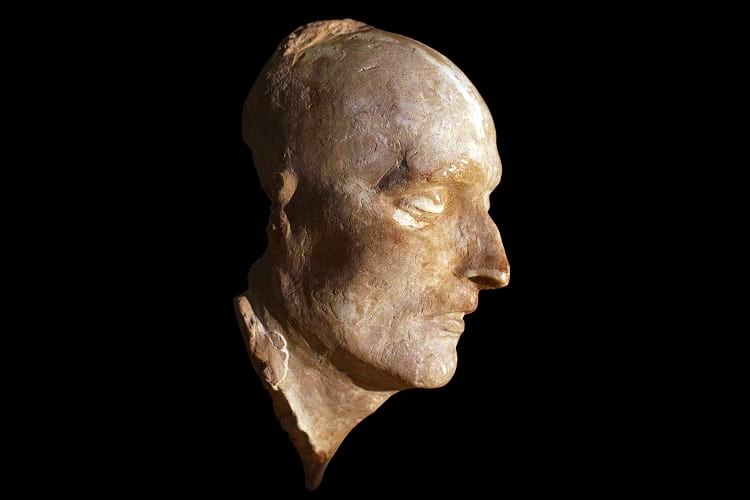
Death mask of Napoleone Bonaparte. (Rama / Wikimedia Commons)
A resemblance of a person’s face, made either from a wax or a plaster cast, subsequent to death and directly from the dead body is essentially what a “death mask” is all about. Death masks have been used in large-scale as an effective means to consign the dead individual to an ever-lasting memory.
Death masks have found a prominent niche either as keepsakes of the dead or for the making of portraits. Sometimes, during the course of the making of the masks, the eyes were slightly tweaked to infuse a hint of aliveness on the subject. To retain the natural humanly elements, these casts brought the actual features out into the open by doing away with any kind of perfections.

Two men in the process of making a death mask. (Bain News Service)
Origin and history of Death Masks
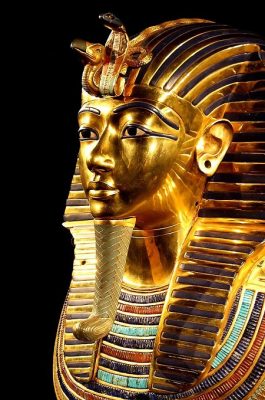
Mask of Tutankhamun. (tdittmar75 / Pixabay)
The tradition of creating a replica of the visage of a dead person is primarily an ancient practice that dates back to the times of the Egyptian Pharaohs and Roman kings.
The death masks were originally used by the Egyptians and Africans to perform some spiritual rituals. The Egyptians used to create the death masks as they had a firm faith that it was imperative to do an appropriate preservation of the dead body as the soul needed to find a refuge to live on, post the demise. Preservation was performed through embalming and mummification.
The most well-known mask belongs to Tutankhamun, the celebrated Pharaoh. His mask was positioned on the body to strengthen the escaping spirit and stand guard over the soul against any evil as a pivotal element in the mummification rite.
The ancient death masks were prepared from wood. Later the Egyptians made use of cartonnage; a special type of material derived from papyrus doused in plaster and finally moulded it on a wooden cast. Royal death masks had engravings of precious metals like gold and bronze.
Most of the death masks were created with marginally enlarged eyes and an imperceptible smile. They displayed the in-vogue fashion with apt relevance in makeup and jewellery. These death masks were afterwards opened out as full body human-shaped coffins with identical decorations and adornments.
Why did people need death masks?
Since the beginning of the Medieval Ages, death masks were put to use as memorials dedicated to the dead. Among a few tribes, death masks found use in ceremonies to offer homage to the departed. These rituals primarily solemnized the creation of the universe and the upheld concept of death as an eternal truth. In others, where there was a sacred connection with the ancestors, they facilitated the transition from the dead to the next ascendant of the family.
Death masks were also used as an instrument to help the soul of the deceased pass effortlessly to the other world. The respect of the burial service customs of mask dancing was also speculated as a means of protection from a likely retaliation from the dead, thereby fending off the risk of a meandering soul.
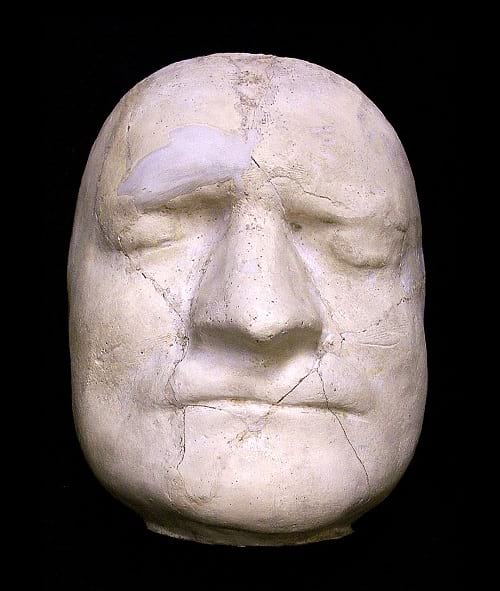
Death mask of Isaac Newton. (The Public Domain Review / Flickr)
In a few cultures, especially in African and Native American societies and among the Oceanic tribes, death masks were looked upon as vital components of religious and social life. They used to believe that death masks opened the door for a medium of communication between the departed and the living in funerary rituals.
Even before photography was invented, death masks found their useful applicability by law enforcement agencies to register the traits of unclaimed bodies with expectations to identify them. Furthermore, death masks came to the aid and abet of the scientific studies of physiognomy.
The procedure of preparing a death mask
It is imperative to complete making the death mask within a few hours after the passing away of a person. This is necessary so as to evade the bloating of the body which in all probability distorts the body characteristics.
The first step involves applying grease on the facial surface to maintain the unscathed nature of the face and easily remove the cast. In the second step, the doctor wraps the face of the deceased with a double layered plaster bandage.

Death mask of Abraham Lincoln. (Internet Archive Book Images / Flickr)
The primary layer would define the subtle elements of the face. The secondary layer would reinforce and make the cast strong. The plaster covering requires a couple of hours to be put down and settle. After removing the plaster, the cast would often be infused with wax or metallic substances to create the illusion of a three-dimensional portrayal.
How Madame Tussaud perfected the art?
It calls for no astonishment to discover that Madame Tussaud was one of the most renowned death mask artists of all times. She made her debut in this art by creating masks of people who perished in the course of the French Revolution.
Nevertheless, later on, she gravitated (although not by her own keenness) to the business of mask creation for executed aristocrats. This implies that most of her subjects were decapitated. Even Marie Antoinette became the model for Madame Tussaud shortly after her passing away.
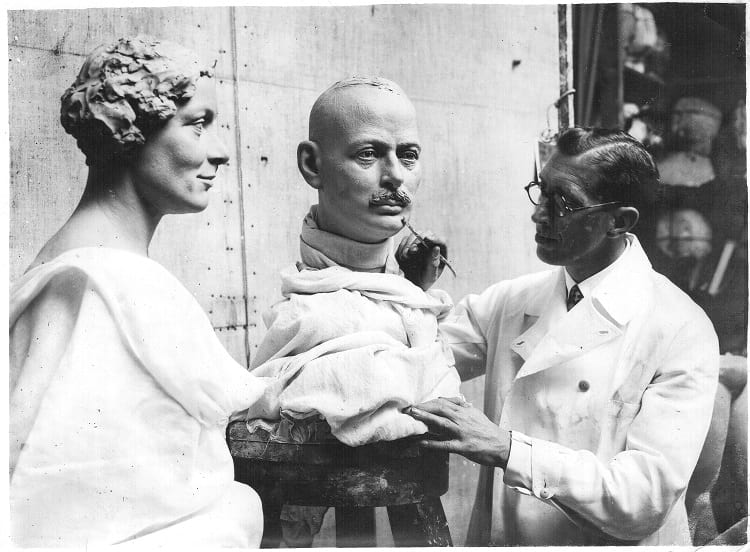
Bernard Tussaud the Great-grandson of Madame Tussaud finishing up the wax figures of Duke of Gloucester and Lady Alice Scott in 1935. (Derzsi Elekes Andor / Metapolisz Images)
Death masks of 7 famous personalities that are on display at various museums
Death masks were made to conserve the visages of the illustrious and historically noteworthy people, from kings, rulers and conquerors to authors, artists, composers and poets.
• Napoleon Bonaparte: Emperor, military and political leader
• John Keats: Poet
• Mary Queen of Scots: Queen of England, Scotland and France (briefly)
• Dante Alighieri: Poet and philosopher
• William Blake: Poet and artist
• Ludwig van Beethoven: Music composer and pianist
• L’Inconnue de la Seine: An unidentified young woman who supposedly committed suicide in the Seine River.
Conclusion
The prevalence and popularity of the death masks have significantly receded in the present times. Nonetheless, people still outstretch considerable efforts to safeguard the memories of their late loved ones with tombstones and custom celebrations.
In spite of the fact that death masks are mostly for the reminiscence of the bygone days, the ritual commemoration of the deceased individuals will live forever beyond any shadow of a doubt.
Recommended Visit:
Madame Tussauds | Museum in London
Fact Analysis:
STSTW Media strives to deliver accurate information through careful research. However, things can go wrong. If you find the above article inaccurate or biased, please let us know at [email protected].
RELATED
The post The Morbid History of Death Masks appeared first on .
]]>The post The Count of Morbid Love: Carl Tanzler and the Dead Maria Elena appeared first on .
]]>
Carl Tanzler outside his building. Circa 1940. (Dewolfe And Wood Collection In The Otto Hirzel Scrapbook / Wikimedia Commons)
Love stories inspire us and give us a reason to dream. Well, not all love stories. Some might end up giving you nightmares. One such bizarre love story is that of Carl Tanzler and the dead Maria Elena ‘Helen’ Milagro de Hoyos. Carl Tanzler, named Georg Karl Tänzler at birth was born on February 8, 1877, in Dresden, Germany.
Early life of Carl Tanzler
He kept moving between countries before finally settling in Australia around 1914. At that time he would boast of being a doctor and an engineer, claiming to have received 9 different professional degrees. Tanzler also alleged that when he was 10 years old, his dead ancestor Countess Anna Constantia von Cosel appeared to him in a dream and showed to him the face of a strikingly beautiful dark-haired woman who would be his true love.
He returned to Germany after the World War I ended in 1918, to be with his mother. He married in 1920 to Doris Anna Shafer and had two children with her, Ayesha Tanzler and Crystal Tanzler. Upon his mother’s insistence, he moved permanently to the United States from Rotterdam on February 6, 1926, to Havana, Cuba in order to provide for a better life for his family. He finally decided to settle down in Zephyrhills, Florida, where his sister was already living and later called for his family.
Tanzler meets the women of his dreams
In 1927 he secured a job at the U.S. Marine Hospital in Florida as a radiology technician and moved there with his family left behind in Zephyrhills. At that time he changed his name to Carl von Cosel after the late Countess Anna Constantia von Cosel. He often signed his hospital records as Count Carl Tanzler von Cosel or Dr. Carl von Cosel. While working at the U.S. Marine Hospital, on April 22, 1930, Carl Tanzler came face to face with the woman of his dreams. Maria Elena ‘Helen’ Milagro de Hoyos, a 20-year-old local Cuban American woman, was the same dark-haired woman Tanzler had visions of and who was to be his true love.

File photo of Carl Tanzler when he worked as a radiologist. (Florida Keys–Public Libraries / Flickr)
Elena, accompanied by her mother had come to the hospital for a medical examination and Tanzler’s heart skipped a beat upon seeing his dream woman alive, in front of him. Elena, the daughter of a local cigar maker Francisco ‘Pancho’ Hoyos, had been married to Luis Mesa since February 18, 1926. Even though Luis left Elena after she miscarried and moved to Miami, Elena was still legally married to him. A fact that did not seem to deter Carl Tanzler.

Elena Milagro Hoyos in 1926, the year she got married at the of 17. (Florida Keys–Public Libraries / Flickr)
Carl’s examination of Elena led to a diagnosis of tuberculosis, which at that time was a fatal disease with no sure cure. Carl Tanzler was not ready to see Elena succumb to her illness and with the permission of her family, started treating her on his own with the hope of miraculously curing her. With his self-professed knowledge of medical science, Tanzler started making concoctions and potions to cure Elena.
He poured all his money into medicines and possible treatments for Elena. At that time, he also became reckless and disrespectful towards hospital authorities. He would illegally transfer x-ray machines, electrical and medical equipment to the Hoyos’ house for Elena’s treatment. All this while, Tanzler showered Elena with exorbitant gifts, jewellery, perfumes, and clothing while proclaiming undying love to her but no evidence has ever been found that Elena reciprocated his feelings.
Death of Elena
In spite of Tanzler’s prodigious efforts, Elena gave in to complications from her disease and breathed her last on October 25, 1931. A distraught Tanzler was adamant about paying for her funeral and with the permission of her family, got an above ground expensive stone mausoleum constructed for Elena in the Key West Cemetery. The Hoyos were oblivious to the fact that Tanzler had the only key to the mausoleum and had an intercom fixed so he could talk to her from the outside. He visited the cemetery every night and also serenaded his dead Elena with her favourite Spanish song. On one such visit in April 1933, Tanzler carted Elena’s body from the mausoleum to his home in a toy wagon.

Stone mausoleum constructed for Elena after her death. (Florida Keys–Public Libraries / Flickr)
According to him, Elena’s ghost, who would come to him every night had asked him to take her away from the grave and marry her. A little after bringing Elena home, Tanzler called a friend and excitedly told him that his Elena had finally agreed to marry him. The friend knew of Elena’s passing away and thought Tanzler was joking. By this time, Elena’s body was fast decomposing and Tanzler got into the task of preserving her body.
He connected her bones with wire hangers to maintain her frame and replaced her eyes with glass eyes. He filled her abdominal cavity with rags and replaced her skin with silk covered with wax and plaster. He even covered her head with a wig made from her own hair that he had taken from her mother. He then dressed her up in a white dress and had a wedding ceremony for the two of them. He slept with Elena’s body every night and danced around the house with it. He sprayed the body regularly with disinfectants and perfumes to cover the foul decaying smell. He even went about buying expensive clothes and jewellery for Elena.

The plastered body of Elena. (Source: www.voltini.com)
Carl Tanzler gets exposed
By this time, people had started noticing his suspicious behaviour. His absence from Elena’s mausoleum, his constant shopping sprees of women’s clothing and other items got people talking. One day, a local boy peeking in from his window, saw him dancing with a giant doll and word spread that Tanzler had probably stolen Elena’s body from the cemetery and got it home.
Sometime in October 1940, rumours reached Elena’s sister, Florinda, who went to Tanzler’s house to confront him and to her horror discovered her sister’s corpse. She informed the authorities who arrested Tanzler and put him on trial for “wantonly and maliciously destroying a grave and removing a body without authorization.” The press coverage gained Tanzler a lot of support from women who found his actions wildly romantic.

Carl Tanzler being interrogated after his arrest. (Florida Keys–Public Libraries / Flickr)
With all the media attention to the case and people wanting to see the preserved corpse, Elena’s body was publically displayed at a local funeral home and people were charged for their visit. Subsequently, Elena was quietly reburied in an unmarked grave to protect her from further tampering. During his trial, Tanzler also said that he had been building a spaceship in which he could take Elena’s body to outer space where the radiation would jolt her back to life. After a preliminary hearing on October 9, 1940, Tanzler had to be released with the charges relating to the case dropped, as “the statute of limitations for the crime had expired“.

The airship Tanzler constructed to take Elena into space. (Florida Keys–Public Libraries / Flickr)

The body of Elena on display after being recovered. (Florida Keys–Public Libraries / Flickr)
His request to get Elena’s body back was denied and he returned to Zephyrhills in 1944 where he lived till he was found dead for 3 weeks in his home in July 1952. A full-size mannequin with Elena’s face constructed from a death mask was found in his home.
Enjoyed this article? Also, check out “In Tsarist Russia Members of the Secret Skoptsy Sect Believed in Self-Castration“.
Recommended Read:
Undying Love: The True Story of a Passion That Defied Death | By Ben Harrison
Fact Analysis:
STSTW Media strives to deliver accurate information through careful research. However, things can go wrong. If you find the above article inaccurate or biased, please let us know at [email protected].
RELATED
The post The Count of Morbid Love: Carl Tanzler and the Dead Maria Elena appeared first on .
]]>The post The Five Punishments for Chinese Slaves appeared first on .
]]>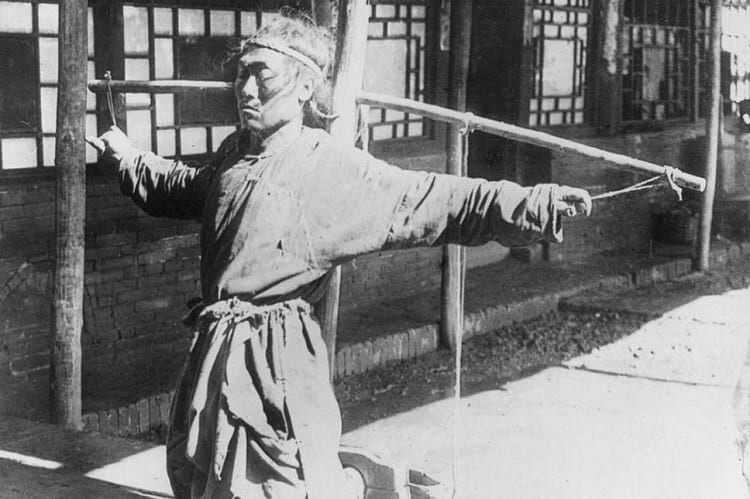
Five Punishments: A Chinese man with hands tied and forced to kneel in public. Circa 1900. (Hawley C. White / Library of Congress)
The journey of mankind has been filled with joy, discovery and wonder. Unfortunately, it has done so alongside pain, evil and shame. To begin the Chinese theme, this connection of opposing sides is symbolic to the famous Chinese philosophy of Yin and Yang, illustrating that conflicting factors are complementary, even dependant on one another. Perhaps the same can be said for crime and punishment, that they are a necessary entity of everyday life.
In much of the world today, forms of torture are frowned upon and even for criminals, alternative forms are encouraged in most countries. It is an attitude that feels right; to save a population from desensitising and returning to a barbaric system of justice. It also inhibits the famous eye for an eye principle which uses a take from me and I take from you legal philosophy.
Anything from money, land or ultimately, an eye. This idiom was first mentioned in the Book of Hammurabi from ancient Mesopotamia – a functioning civilisation which harboured torturous punishments also. Much of the world has changed so much since that time making it hard to imagine that torture was once a mainstay. Commonly practised and an accepted form of punishment in every corner of the world, even within governments. One such place was and is the great land of China.
Punishments for slaves in Old China
This is best proved by the fact that the death sentence is still passed in China today, illustrating that corporal punishment is not designated to the past, and perhaps has a place in the future. There are also the numerous reports that torture techniques are still in practice, for example in secret prisons. China is one of the cradles of civilisation, as one of the oldest continuous cultures in the world.
The first written history comes from a period known as Dynastic China when the Xia Dynasty ruled from 2070 BCE. It is in the centuries before this period when a series of horrifying penalties known as The Five Punishments were written to keep slaves under control and maintain social order. Slavery was a massive cog in the Chinese economic system during this time.
People were born, sold or captured into slavery and their main duties – within a tough life – would be farming. Some slaves would also work with the dynastic families themselves. Around the centuries before the inception of the Xia, these punishments were created although their exact origins are unknown. They seem to have originated from an indigenous people known as the Hmong (Miao) however, a group from the south of China.
The reason for this is that a famed warrior known as Chiyou is heavily involved. His specific clan was unknown but many link it to the Hmong or their allies. For instance, the Sanmiao or the Nine Li. He is regarded as a mythical king and a great warrior. The Xia dynasty adopted these punishments and made them known to their people. They were for men only as women had their own separate punishments which will be listed later.
Five Punishments in Dynastic China
- Face tattooed with permanent ink.
- Nose cut off without anaesthetic
- Removal of foot/feet or kneecap without anaesthetic
- Removal of reproductive organs without anaesthetic
- Death in various forms (including quartering (cutting the body into four pieces), decapitation, drawn out by chariots, strangulation/asphyxiation, slicing by thousands of small cuts.)
In 221 BCE, a ruler called Qin Shi Huang brought about a time known as the Imperial Era. He conquered the dynastic states and made himself Emperor of the collective land known as Qin, later to be called China. During this imperial era his reforms made the punishments less barbaric but none the less still torturous. The improvement of standards is attributed to the teachings of famous philosopher Confucius and his views on human life. The Imperial penalties were as follows,
- Bamboo lashes to the buttocks (the number of lashes depended on the nature of the crime)
- Stick lashes to the back, buttocks or legs
- Penal service (ranging from 1-3 years)
- Exile – (this would be to a remote location such as the island of Hainan to the south, the distance depended on the crime)
- Death (strangulation, slicing or decapitation)

A lawbreaker being whipped while two men restraint him. (Ralph Repo / Flickr)
It must be said that slaves could also pay their way out of these brutal punishments but the prices were extortionate meaning that very few could do so.
For females the punishments were different. There are no concrete reasons why at this point it is simply thought that because China was a patriarchal society in which woman were not held responsible for their crimes. And that they could not suffer as much as male serfs. As follows,
- Forced to grind grain
- Fingers squeezed between sticks
- Beaten with wooden sticks
- Forced suicide
- Solitary confinement (time dependant on crime) or Sequestration (losing assets).
As mentioned, although torture was inherently part of life in all corners of the world, in Chinese culture it seems incredibly more brutal, especially to be so intertwined with government and society, somewhat uniquely. Perhaps the extreme scale of the land and the amount of warring factions gave a higher rise for the need to control. China is such a different world – as are many – for outsiders to comprehend.
There are many works which try to associate the mindset, for example to why their laws arose and why many still continue. Skipping over the nature which brought about torture in the first place (as that would require a tome to even attempt to fathom why) we will look instead at the change from Dynastic to Imperial. When punishments looked to improve after people started becoming enlightened.
This possibly began when the teacher and philosopher Confucius resided and taught. Born in 551 BC his teachings spread more after his life ended and influenced many of his countrymen. The work Crime and Punishment in Ancient China and its Relevance Today explains more,
“Confucianism was designed to maintain civility in the absence of central authority by persuading leaders to create a harmonious society based on the limited use of raw power and punishment.”
Helping Confucianism was the cosmological tradition which was established after his death, around 330 BC during the Warring States Era. This was where many dynasties vied with each other to create an Empire. Like the five punishments, this tradition is based on the five major planets and the elements they represent: Venus (metal), Jupiter (wood), Mercury (water), Mars (fire) and Saturn (Earth). The people used this to monitor agriculture, climate, politics and warfare. In 170 BC a document was found relating these five entities to each other. It is called the Five Star Oracle. Confucianism, as well as the cosmological tradition helped people in this aspect by introducing more moralistic behaviour and by trying to attain a balance among nature. Punishments were not just required for social order but to balance complex natural phenomena. Deborah Cao explains more,
“The cosmologists believed that without an appropriate effort to remedy the social harm caused by a crime, the disturbance of the human order would affect the larger cosmic order of things. Through negative natural phenomena, such as… floods, disturbances of the cosmos would in terms have a negative impact on the human world.”
Although this period certainly lessened torture techniques, the death penalty continued was implemented and advocated by Shang Yang (390 BCE). He founded Chinese Legalism which promoted a strict system. Crime and Punishment in Ancient China and its Relevance Today again explains more.
“The Legalist tradition restored harsh punishment as a way to impose order upon a fragmented society in which local despots had been carrying out arbitrary judgments. But Legalism carried the seeds of its own destruction and required Confucianism to balance it in creating a durable system of governance and justice.”
It looks as though each system – Confucianism and Legalism – worked alongside each other, again like an interconnected Yin and Yang. This was perhaps one of the first documented times that legality and severe punishment went hand-in-hand with socialism. With it, more thought was put into social problems.
Cangue Punishment
Punishment of course continued in other forms. Here is an example of a torture used even until the 20th century, a technique called a Cangue board used in many parts of Asia. It was implemented in other parts of the world also such as England where it was known as a Pillory. The Pillory device, however, would be fixed to the ground while the Cangue could be moved by the recipient if needed. It obviously restricted movements even to the point where people could not feed themselves, resulting in starvation in many cases unless they had friends and family to help them, otherwise strangers. The prisoner would be in the Cangue for as long as the punishment merited, it was mostly the sentence for thieves.

A man being punished by cangue. (John Thomson / Wellcome Images)
These methods continued until China became a Republic in 1912. Then it became westernised and more socialism brought about changes in punishment techniques, making them less brutal. Although as shown with the death penalty, the older traditions remain in China, whereas in other countries the death penalty has been outlawed completely. China, according to Amnesty International accounts for the majority of capital punishments on Earth.
Like many countries, China developed a culture of punishment and torture. However, unlink many countries such as in Western Europe they have kept aspects of it such as the death penalty. There are also many reports regarding punishments similar to the Five going on in secret prisons known as ‘Black Prisons’. The famous bamboo shoot and water torture are a few of the methods practiced.
European installations like the Council of Europe make banning capital punishment a mainstay if a country wishes to join. This is to do with the miscarriage of justice which can occur. More is explained in a deep study by the Economist. It is not just a sentimental gesture, however. Another reason is for keeping political contests fair, as many reports of killing political opponents this way have been reported none more so in China.
“For many emerging democracies, abolishing the death penalty has also been a way to make a decisive break with an authoritarian past, when governments used capital punishment not just to punish criminals but to get rid of political opponents, as China currently seems to be doing in Xinjiang against the province’s Muslims.”
This will long be a contentious element between nations on whether the death penalty is just. For the reasons above it seems a valid argument to abolish it yet oppositely, for serial killers and crowded prisons it becomes more apt. But just where can the line be drawn or known between the two.

Rebels undergoing a slow painful death inside a cage. (Jeff Lea / Wikimedia Commons)
A clearer point can be with torture. It seems simpler in that there is now a consensus flowing through the world that any form of torture is wrong, whatever the crime. It still goes on, that goes without saying but soon hopefully it will be completely resigned to the past. Even reading about these torture techniques is absolutely harrowing, to think of what some people went through, some no doubt innocent. May they rest in peace and be eternally remembered so that the practice of torture is ceased, once and for all.
Enjoyed this article? Also, check out “The Head Crusher – A Renaissance Torture Device for Slow and Incrementally Agonising Punishment“.
Recommended Read:
1. Chinese Language in Law: Code Red | By Deborah Cao
2. Crime and Punishment in Ancient China | By R. H. Van Gulik
Fact Analysis:
STSTW Media strives to deliver accurate information through careful research. However, things can go wrong. If you find the above article inaccurate or biased, please let us know at [email protected].
RELATED
The post The Five Punishments for Chinese Slaves appeared first on .
]]>


